Schedule a Call
Get started with your organic growth journey!



Get insights on AI, productivity, and the future of work.


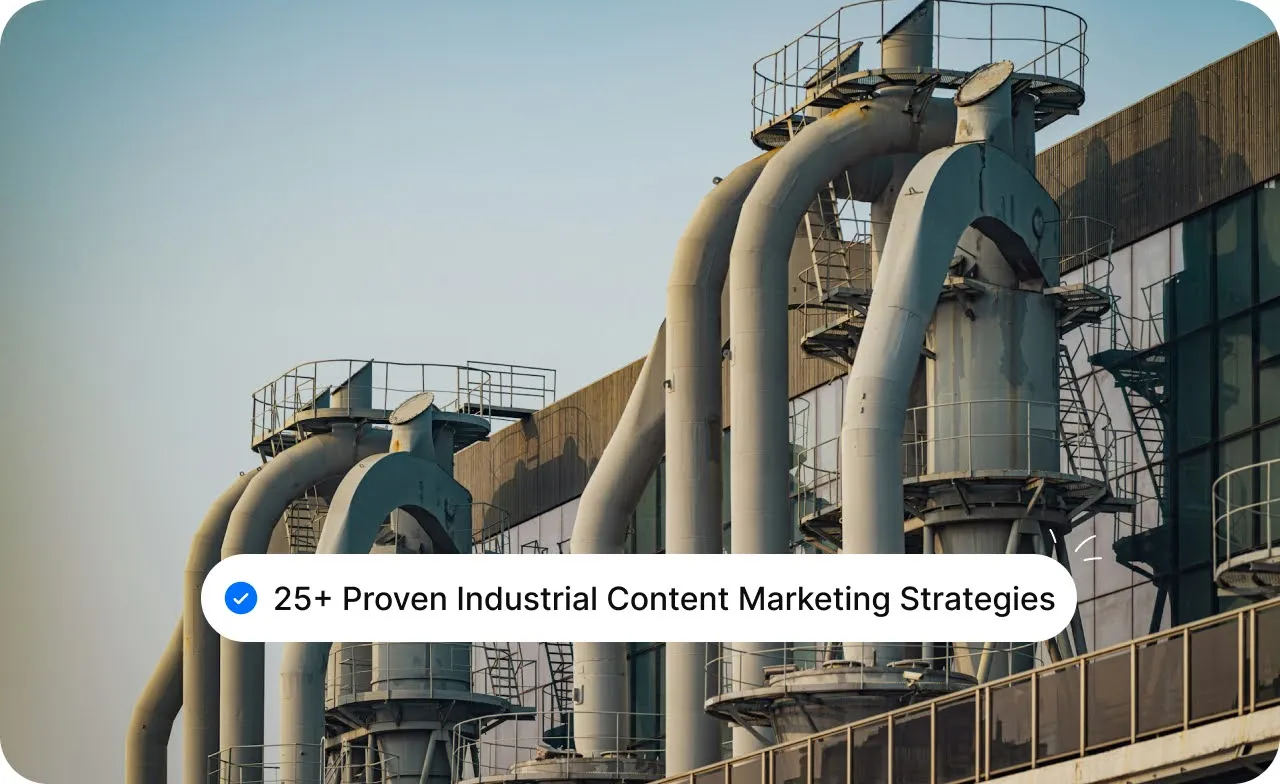
For industrial companies, attracting the right decision-makers is a challenge.
High-quality leads who understand the complexities of your products and their impact on operations are difficult to find. If your sales team spends more time sorting through unqualified leads than focusing on high-value prospects, you're facing a common issue.

Selling complex machinery or custom parts requires a content strategy that speaks directly to engineers, procurement managers, and operations teams, all of whom prioritize precision and quality.
This guide shows how to create content that targets the right buyers and leverages content marketing strategies to convert them into loyal customers.
In the awareness stage, the goal is to capture attention and build recognition for your brand.
For industrial companies, this is about introducing your solutions to a broad audience and offering valuable information that addresses common industry pain points.
Here’s how you can use educational content to engage potential customers and guide them through the early stages of their journey.
Educational blog posts are a powerful tool for attracting organic traffic. These posts address common pain points in the manufacturing industry and offer solutions, making them highly valuable for your target audience.
Step-by-step how-to guides are another great way to capture interest. These guides provide potential customers with detailed instructions on common manufacturing processes, making complex concepts easier to understand.
Infographics simplify complex data, making them an engaging way to educate your audience. Visual content is highly shareable and can be used across different platforms to reach a broader audience.
Social media is a critical channel for engaging with your audience, especially on LinkedIn and Instagram. Regular posts can help build awareness, share industry insights, and show the human side of your business.
Actionable Tip: Share behind-the-scenes content and industry tips to make your company more relatable to your audience.
Webinars are an excellent way to dive deeper into industry topics and trends. Hosting webinars about manufacturing technology, sustainability, or emerging industry innovations helps position your company as a thought leader.
Actionable Tip: Record these webinars and offer them as on-demand content for people who couldn’t attend live.
Podcasts are becoming increasingly popular as a way to share insights on complex manufacturing topics. Featuring interviews with industry experts helps establish your company as a knowledgeable voice in the industry.
Actionable Tip: Repurpose podcast content into blogs or social media posts to expand your reach.
SEO-optimized articles are the backbone of any successful content marketing strategy. By targeting long-tail keywords, your articles will rank higher in search results and attract highly relevant traffic.
Video tutorials are highly engaging and give your audience a clear understanding of how your products work. They’re perfect for breaking down complex processes or demonstrating your products in action.
Example: “Watch How Our Machines Reduce Production Time by 30%”
Actionable Tip: Use YouTube or Vimeo to host your videos, and ensure they are easily shareable.
Written customer testimonials provide social proof and show how your products have solved real-world challenges. Sharing success stories builds trust with potential customers.
Actionable Tip: Feature testimonials prominently on your landing pages and use them as supporting content in blogs or product pages.
Interactive quizzes engage visitors by helping them find the right manufacturing solution for their needs. These quizzes serve as an excellent way to collect leads while providing value upfront.
Actionable Tip: Use quizzes like “Which Manufacturing Solution is Right for Your Business?” to segment leads and tailor future content accordingly.
Once you’ve attracted potential leads in the awareness stage, the next step is to nurture those leads and build long-term relationships.
This is where you move beyond simply catching attention and start establishing trust, showcasing value, and deepening your connection with prospects.
The goal is to engage them more meaningfully and guide them further down the sales funnel.
Case studies are one of the most effective tools for nurturing interest and building credibility. They provide detailed examples of how your product or service has successfully solved real-world problems for other businesses.
By showcasing real-life results, such as increased efficiency, cost savings, or improved productivity, you demonstrate the tangible value of your offerings.
They address their fears, answer their questions, and show them exactly how you can make a difference in their operations.
To further build authority and establish thought leadership, whitepapers provide in-depth analysis on industry-specific issues, trends, and emerging technologies. These comprehensive, research-driven reports can be used to discuss everything from market shifts to advancements in manufacturing technologies.
Offering such valuable insights helps position your brand as an industry expert, trusted by decision-makers in the field.
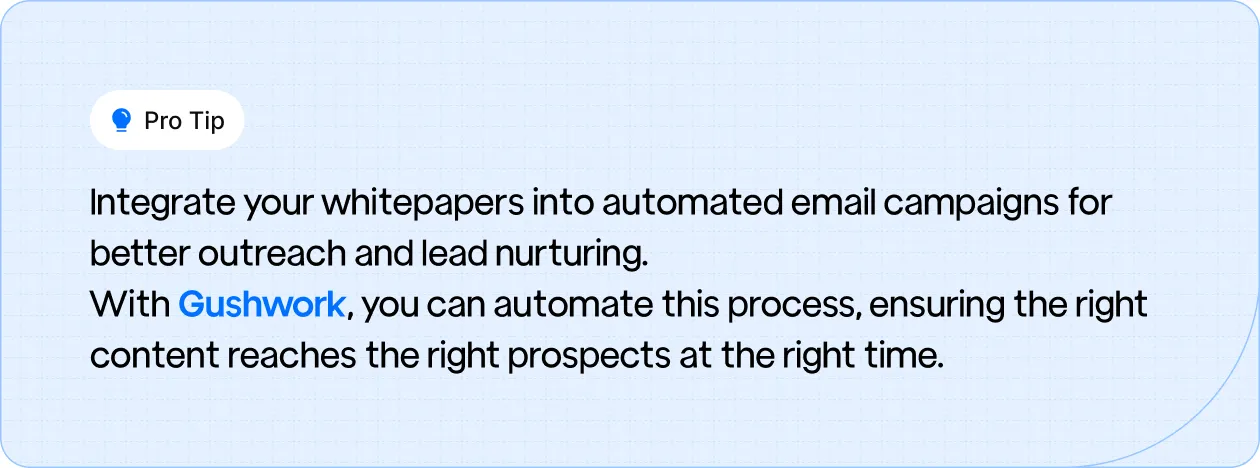
Product demos are critical at this stage to demonstrate how your solution works in real-life scenarios.
Whether it’s a video showing your product in action or a live demo with an expert explaining key features, these interactive formats can significantly boost engagement.
When prospects are actively evaluating solutions, they’ll have many questions about your products, services, or industry. A comprehensive FAQ blog post addresses these questions upfront, providing clarity and reducing hesitation.
Comparison sheets are valuable tools that allow prospects to directly compare your product’s features and benefits with those of competitors. By highlighting key differentiators, you can showcase why your solution is a better fit for their needs.
Sharing customer success stories is an excellent way to demonstrate your product’s value in a real-world context. These stories highlight the impact your solution has had on your clients’ businesses, helping prospects envision similar success for themselves.
Why It Works: Success stories humanize your brand, showing potential customers that others just like them have benefited from your products or services. These stories build trust and increase the likelihood of conversion.
Technical webinars give you the opportunity to dive deep into the specific features and benefits of your products. By addressing complex topics like the science behind your manufacturing process or how your technology works, you can engage highly interested leads who are looking for more detailed information before making a decision.
They also position your company as a technical leader in your field.
An ROI calculator is a powerful tool for helping prospects visualize the potential return on investment they’ll receive from your product. By allowing them to input their own data, you provide a personalized, data-driven reason to move forward with your solution.
Why It Works: Calculators help prospects understand the real-world value of your product in a quantifiable way, making them feel more confident in their purchasing decision.
Email newsletters are a great way to stay top of mind with your prospects by delivering consistent, valuable content. Whether it’s industry news, product updates, or exclusive insights, newsletters keep your audience engaged while nurturing them along the buying journey.
Why It Works: Regular emails allow you to segment your audience based on their interests and behaviors, sending them tailored content that resonates with their specific needs.
This targeted approach increases engagement and fosters stronger relationships.
The decision stage is the final step in the buyer’s journey, where prospects are close to making a purchase. At this point, they need reassurance, final details, and a compelling reason to choose your solution over others.
Your goal here is to address any lingering questions, offer value, and create a sense of urgency to encourage the prospect to take the next step.
Let’s look at the key content strategies to close the deal and convert leads into customers.
Offering free trials or demo access is one of the most effective strategies to move prospects from the consideration phase to the decision phase. When a prospect can experience your product or service firsthand, they can see the value for themselves and feel more confident in their decision.
This hands-on experience can be the final push they need to make a purchasing decision. By showing them exactly how your solution addresses their pain points, you increase the likelihood of conversion.
At the decision stage, prospects are looking for specific, in-depth information about your product. Offering detailed product guides that cover everything from features and benefits to technical specifications helps answer any lingering questions.
This content provides clarity and gives prospects all the information they need to make an informed choice.
Why It Works: Providing comprehensive product guides demonstrates transparency and allows prospects to fully understand how your solution works and how it will meet their needs.
This thoroughness helps build trust, making it easier for the customer.
Video testimonials are a powerful tool at the decision stage because they offer social proof from real customers who have already benefited from your product.
Hearing firsthand experiences from satisfied clients can provide the final bit of reassurance that your solution works as promised.
Why It Works: Video testimonials are more engaging than written ones, as they convey emotion and authenticity. They can effectively showcase how your product has impacted real businesses, helping to alleviate any doubts or concerns the prospect might have.
A satisfied customer’s voice is one of the strongest forms of validation.
At this stage, prospects often need personalized consultations to understand how your product fits their unique needs.
Offering one-on-one consultations provides an opportunity to address specific questions, tailor solutions to their business, and demonstrate how your product can solve their problems.
Why It Works: Personalized consultations show that you care about the prospect’s individual needs and are willing to work with them to find the best solution.
This level of attention increases the likelihood of closing the deal and builds a stronger, more trusting relationship.
Product reviews from other users provide additional validation and help prospects see that others have had positive experiences with your product. Highlighting these reviews, especially when they focus on key selling points, can reassure prospects that your solution is reliable and effective.
Why It Works: Product reviews, particularly those from customers in similar industries or with similar challenges, offer relevant social proof that can influence decision-making.
They provide real-world evidence that your product lives up to its claims and meets the customer’s needs.
Creating a sense of urgency can help push prospects over the finish line. Limited-time offers or exclusive deals incentivize immediate action and can be the final nudge needed to close the deal.
Offering gated content like eBooks, in-depth case studies, or industry reports in exchange for prospect contact details is a great way to further nurture leads at this stage.
Gated content provides high-value information that prospects may need to finalize their decision while allowing you to capture lead data for further nurturing.
Why It Works: Gated content is a proven lead generation tactic. By offering something of value that helps prospects make informed decisions, you position your company as a helpful and knowledgeable resource.
This further reinforces trust and keeps the prospect engaged.
A comprehensive buyer’s guide helps prospects understand how to evaluate different products and select the right solution for their needs. This guide should provide clear comparisons, highlight key features, and emphasize the benefits of your solution over others.
Why It Works: A buyer's guide simplifies the decision-making process by breaking down the product selection criteria.
By including testimonials and specific use cases, the guide also builds credibility, offering a clear path to conversion for the prospect.
Live Q&A sessions offer an interactive way to engage prospects and address any last-minute questions or concerns. These sessions create a sense of immediacy and transparency, allowing prospects to ask about product features, pricing, and other key factors before making their final decision.
Why It Works: Live Q&A sessions humanize your brand and provide real-time feedback. Prospects are more likely to trust a company that is open to answering questions in an open forum, especially when it comes to complex, high-value purchases.
Finally, providing custom proposals is a powerful way to seal the deal. Personalized proposals should outline the exact solution you’re offering, the pricing, and any unique considerations for the prospect’s business.
Why It Works: Custom proposals show that you’re not offering a one-size-fits-all solution. By tailoring your offer to the prospect’s specific needs, you demonstrate your commitment to providing the best solution for their unique situation.
This personalized approach makes the decision to purchase much easier.
Marketing automation, AI-powered tools, and analytics platforms are transforming the way manufacturers approach content marketing.
These technologies not only streamline workflows but also enhance efficiency, allowing you to deliver the right content to the right audience at the right time.
Marketing automation tools help manufacturers automate repetitive tasks like email campaigns, content distribution, and lead nurturing.
This reduces manual work, freeing up time for strategic initiatives while allowing you to personalize content for different audience segments.
Benefits:
Real-World Example: Gushwork automates marketing workflows, delivering tailored content at critical stages in the buyer's journey.
Read how A Manufacturing Tech Brand Goes From Chasing Customers to Attracting 78 Leads with Gushwork.
AI-driven tools can help manufacturers speed up content creation and optimize SEO, ensuring content is fresh, relevant, and effective in driving organic traffic. From content generation software to predictive analytics, these tools empower smarter, data-backed decisions.
Benefits:
Real-World Example: AI-powered platforms like Gushwork help manufacturers identify high-converting keywords and optimize content for better results.
Read how John Maye Got 17 Leads in The First 30 Days of Adopting AI SEO with Gushwork.
Effective analytics tools enable manufacturers to track key metrics like website traffic, conversion rates, and engagement to continuously optimize content. Data-driven insights ensure you focus efforts on what’s working and adjust strategies where necessary.
Key Metrics to Track:
Benefits:
Maximizing content reach is vital for driving engagement. Content distribution technologies ensure your message reaches the right audience across channels like social media, email, and your website, while allowing you to track and optimize performance.
Benefits:
Real-World Example: Gushwork integrates with marketing platforms to automate content distribution and provide real-time tracking, helping optimize campaigns.
You now have 25+ proven content marketing strategies specifically tailored to industrial companies, designed to attract, engage, and convert leads at every stage of the buyer’s journey.
However, to truly scale your marketing efforts and ensure long-term success, managing content manually isn’t enough.
You need tools that automate processes and help you deliver content at the perfect moment for maximum impact.
Q1. What are some effective content marketing strategies for industrial companies?
A1. To successfully engage industrial audiences, start by creating educational blog posts that address common industry pain points. Additionally, use case studies, product demos, webinars, and how-to guides to build credibility and trust. Focus on providing high-value content that speaks to the specific needs of engineers, procurement managers, and operations teams.
Q2. How can marketing automation help in industrial content marketing?
A2. Marketing automation tools help manufacturers automate repetitive tasks like email campaigns and content distribution, saving time and increasing efficiency. With automation, manufacturers can ensure the timely delivery of targeted content to prospects at key stages of the buyer’s journey, improving engagement and nurturing leads effectively.
Q3. How does AI improve content creation for industrial companies?
A3. AI-powered tools like content generation software and predictive analytics platforms can speed up content creation, optimize SEO, and deliver personalized content at scale. These tools also help identify high-converting keywords and assist manufacturers in targeting their content to the right audience for maximum impact.
Q4. What role do case studies play in industrial content marketing?
A4. Case studies are invaluable for showcasing real-world success stories and demonstrating how your product has solved specific problems. They build credibility by providing potential customers with relatable examples of how your solution can improve efficiency, reduce costs, or enhance productivity.
Q5. How can SEO-optimized content help attract industrial buyers?
A5. SEO-optimized content ensures your blog posts, articles, and web pages rank higher in search results, making it easier for potential customers to find you. By targeting long-tail keywords specific to industry pain points and solutions, you can attract qualified leads who are actively searching for answers to their challenges.
Q6. Why should I use interactive content like quizzes in industrial content marketing?
A6. Interactive content, such as quizzes, engages your audience and helps you gather valuable data on their needs and preferences. By offering quizzes that guide users to the right manufacturing solution, you can generate qualified leads and personalize follow-up content, improving conversion rates.
Q7. How can analytics tools optimize my industrial content marketing strategy?
A7. Analytics tools help track key metrics like website traffic, engagement rates, and lead conversion. By analyzing this data, manufacturers can identify which content resonates best with their audience, refine strategies, and optimize content distribution for better results and higher ROI.
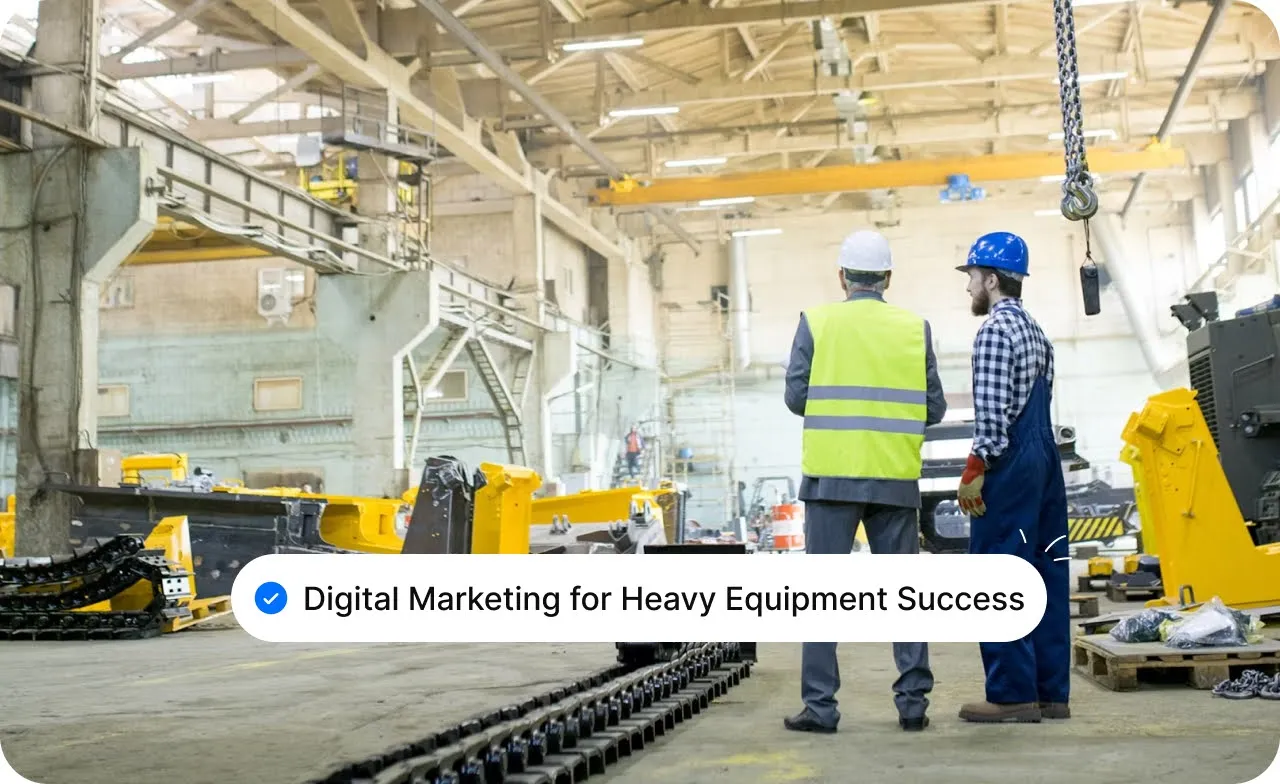
Selling heavy equipment isn't as simple as making a quick sale. It's about cultivating trust and relationships over a long buying cycle, something that's increasingly happening online.
The problem? Many heavy equipment companies are still relying on traditional marketing methods like print ads or word-of-mouth, hoping they’ll catch the right lead. But with today’s buyers already doing their research online before even reaching out, this approach just doesn’t cut it anymore.

The real issue is attracting the right leads, those who are actively searching for the equipment you sell and value the specific features you offer.
This guide is here to help you move beyond outdated tactics and implement digital marketing strategies that target your ideal audience, streamline your sales cycle, and drive meaningful results.
The heavy equipment industry, much like other sectors, has been heavily influenced by digital transformation in recent years. Traditional marketing methods, such as print ads and cold calls, are rapidly losing their effectiveness.
Buyers in the heavy equipment space now look online first for information, reviews, and purchasing options.

Digital Marketing today is more of a necessity and less of a preference. As competition intensifies and customer behaviors change, heavy equipment companies must adapt to stay relevant.
Shifting from outdated marketing tactics to digital solutions is crucial for survival.
Digital marketing enables you to reach your audience where they already are, online, and armed with information that will guide their purchasing decisions.
Understanding your audience is the first step to crafting a marketing strategy that resonates. In the heavy equipment market, key decision-makers like contractors, fleet managers, and project planners are the ones pulling the trigger on purchasing decisions.
But what makes them tick?
By knowing these motivations, you can tailor your messaging and ensure you're speaking directly to their needs.
Digital marketing can help you stay visible and provide the information your prospects need to make informed decisions when the time is right.
If your company isn’t visible in those searches, you’re missing a critical opportunity to connect with high-quality leads.
Your website is the cornerstone of your digital marketing strategy. It’s where leads are generated, relationships are built, and deals are closed. But to turn casual visitors into customers, your website needs to be more than just a digital brochure.
Key Features Your Site Must Have:

SEO (Search Engine Optimization) is critical for heavy equipment companies. If your potential customers are searching for equipment online, your website needs to show up at the top of search results. Local SEO is especially important for equipment dealers, as many customers are searching for solutions nearby.
![Use high-intent long-tail keywords like “excavator rental in [city]” to target ready-to-buy customers.](https://cdn.prod.website-files.com/6614dca1d3aa7b076d6f3004/68e353c5cf99e31547a17466_ac0b244f.webp)
While SEO helps you build long-term traffic, paid ads (PPC) provide immediate results. With PPC, you can target specific, high-intent search terms that can lead to quick conversions.
For heavy equipment companies, terms like “buy excavators” or “heavy equipment rental near me” can drive highly relevant traffic to your website right away.
For example, if someone is searching for “excavator rental in [city],” you can target that exact phrase with a paid ad, ensuring you’re visible at the moment they’re looking for solutions.
Remarketing ads can help bring back visitors who didn’t convert on their first visit, keeping your brand top of mind.

Social media isn’t just for consumer brands. For heavy equipment companies, it’s a valuable tool to engage with your audience, share behind-the-scenes insights, and showcase your products in action.
Focus on the Right Platforms:
Content Strategy:

Content marketing is about providing value that solves real problems for your audience.
For heavy equipment companies, content like blogs, case studies, videos, and how-to guides establishes credibility and positions your company as an industry expert.
Examples of Effective Content:
Real-World Impact

Use website forms, gated content, and social media to capture leads. The goal is to build a high-quality, segmented list to nurture prospects effectively.
Types of Emails That Work:

Balancing SEO and PPC is crucial for heavy equipment companies to reach the right buyers at the right time. Combining both strategies ensures you capture immediate leads while building lasting online visibility.
When to Use Each:

Tracking the right metrics is essential for understanding the effectiveness of your marketing efforts. Focus on key performance indicators (KPIs) that drive results and optimize your strategy.
Metrics to Monitor:
Tools You Can Use:

The heavy equipment market is highly competitive, and relying on scattered tactics isn't enough. Success comes from a strategic, integrated approach that combines SEO, PPC, content marketing, and social media to connect with the right buyers at the right time.
The real challenge is about consistently attracting qualified leads while demonstrating trust and credibility in every interaction.
Q1. How can digital marketing help my heavy equipment business grow?
A1. Digital marketing enables you to reach a broader audience, build brand awareness, and generate qualified leads. By leveraging SEO, PPC, content marketing, and social media, you can attract potential customers actively searching for equipment and services online.
Q2. What are the key components of a successful website for heavy equipment companies?
A2. A well-structured website should include:
Q3. How important is SEO for my heavy equipment business?
A3. SEO is crucial for improving your website's visibility in search engine results. By optimizing your site with relevant keywords, local SEO strategies, and quality content, you can attract more organic traffic and potential customers.
Q4. Should I invest in paid advertising for my equipment business?
A4. Yes, PPC campaigns can provide immediate visibility and drive targeted traffic to your website. By focusing on high-intent keywords and platforms like Google Ads and LinkedIn, you can reach decision-makers and generate quality leads.
Q5. How can social media benefit my heavy equipment company?
A5. Social media platforms like LinkedIn, Facebook, and Instagram allow you to showcase your equipment, share customer success stories, and engage with your audience. Consistent posting and interaction can build brand loyalty and attract new customers.
Q6. What role does content marketing play in my digital strategy?
A6. Content marketing helps establish your authority in the industry by providing valuable information to your audience. Blog posts, case studies, videos, and how-to guides can answer customer questions, showcase your expertise, and improve SEO.
Q7. How can I measure the success of my digital marketing efforts?
A7. Track key performance indicators (KPIs) such as website traffic, conversion rates, lead quality, and return on investment (ROI). Utilize tools like Google Analytics, HubSpot, and LinkedIn Analytics to monitor and adjust your campaigns for optimal performance.

Selling A/V systems is about attracting the right kind of leads who understand the complexity and value of your products.
The challenge? Many manufacturers waste money on digital marketing strategies that bring in tire-kickers instead of qualified buyers.

With long sales cycles and niche buyers, you need a marketing agency that specializes in A/V manufacturing and knows how to engage your target audience effectively. This is about finding the decision-makers who are already looking for solutions like yours.
This guide will show you how the right marketing agency can make all the difference in turning your digital efforts into measurable growth.
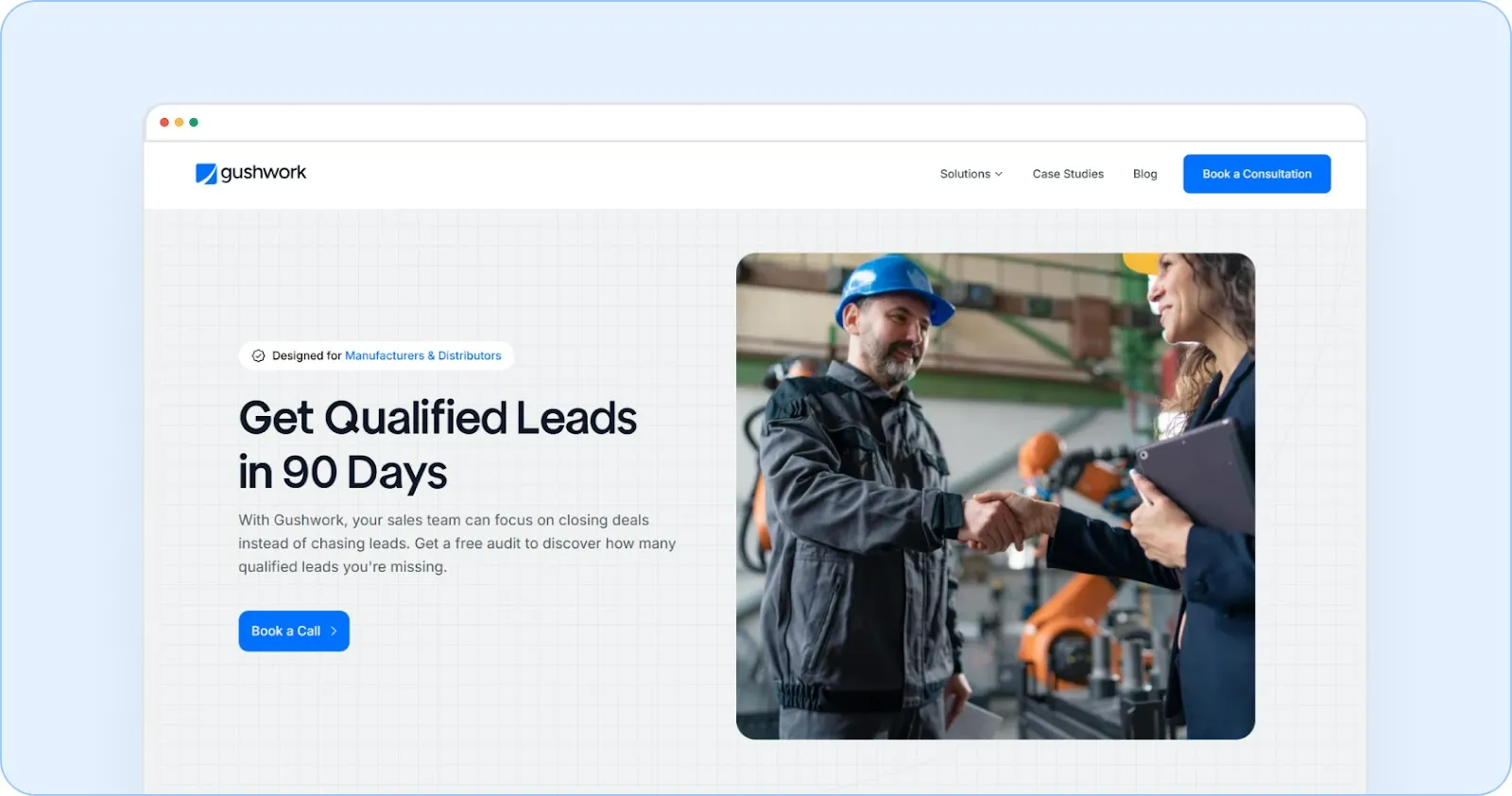
Gushwork stands out as a digital marketing agency that truly understands the unique needs of A/V manufacturers. With extensive expertise in the sector, Gushwork offers tailored solutions to help A/V businesses achieve their marketing goals.
Their strategies, including SEO, PPC, content marketing, and lead generation, are carefully crafted to ensure measurable results.
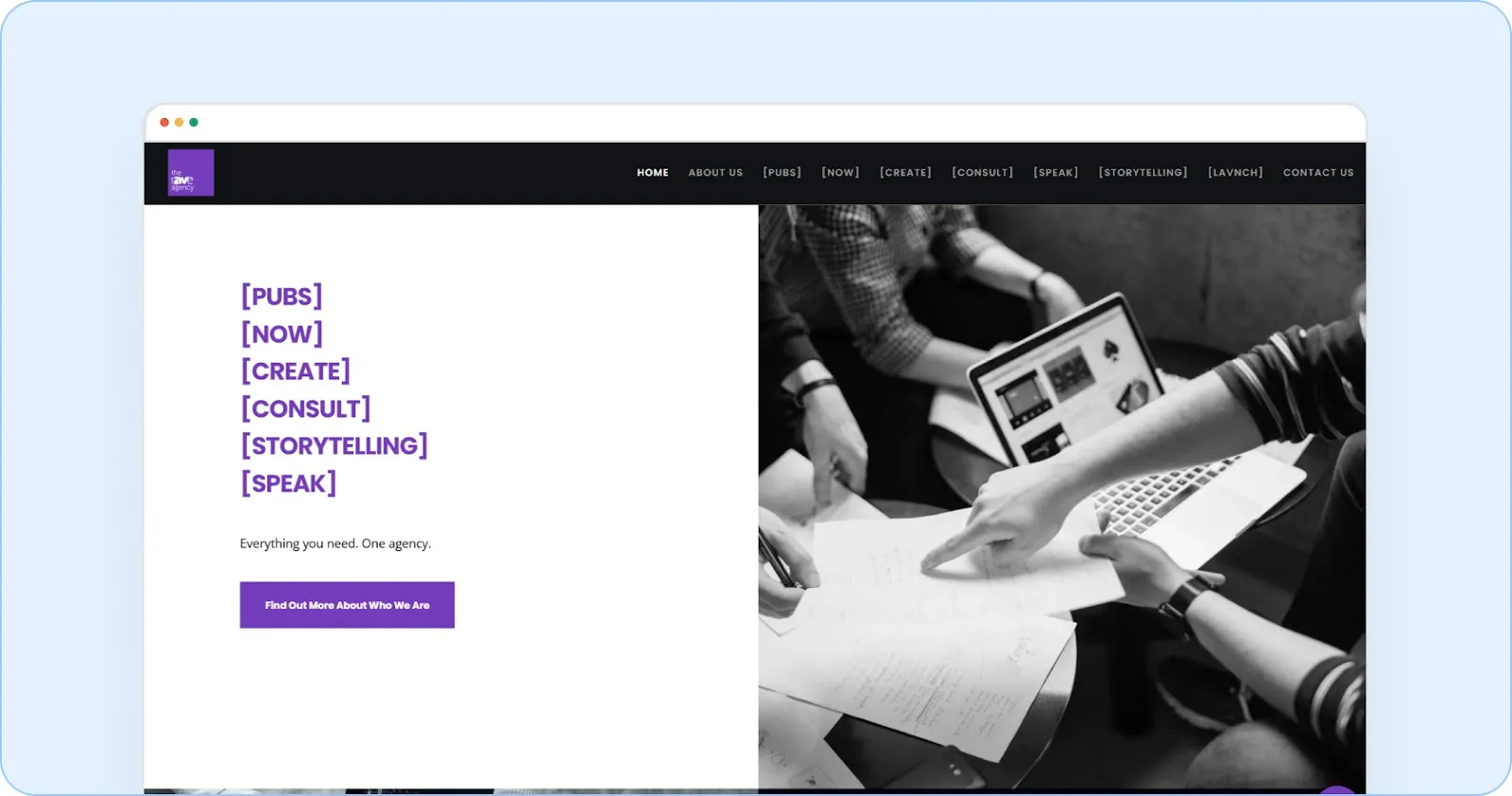
THE rAVe Agency brings over 45 years of combined experience to the table, with a clear focus on elevating brand visibility and engagement. Their expertise in creative, editorial, and strategic services has helped many A/V companies develop strong, engaging marketing campaigns.

AV Marketing specializes in helping A/V manufacturers drive sales and improve their online presence. Offering services like SEO, PPC, and web design, they focus on customer acquisition and building a strong brand identity.
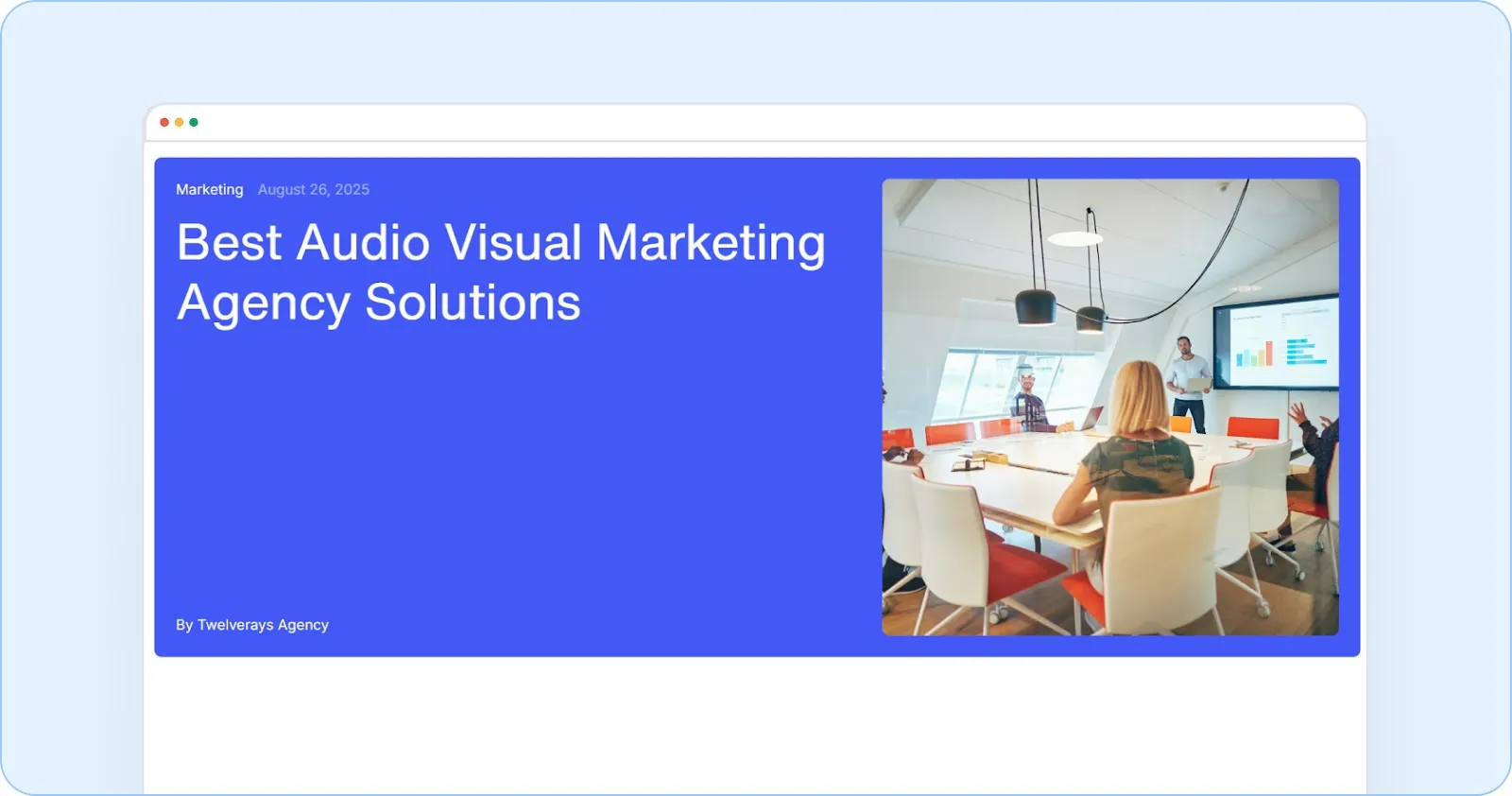
Twelverays excels in creating engaging audio-visual content that resonates with A/V manufacturers’ target audiences. By integrating visual storytelling with strategic marketing, they drive brand recognition and improve user experience.
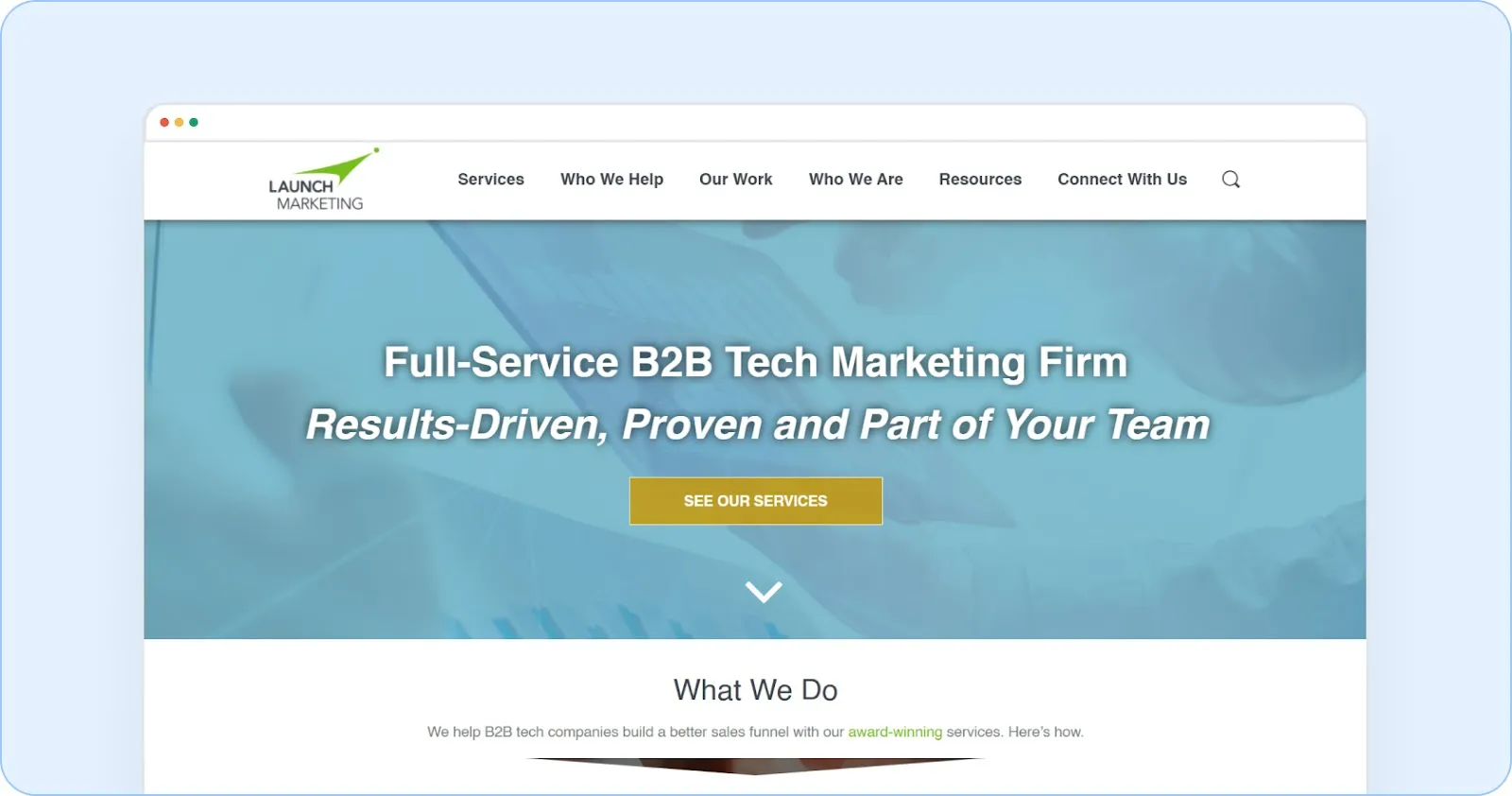
Launch Marketing focuses on B2B marketing strategies designed to elevate A/V manufacturers in competitive markets. Their services, including strategic campaign planning and content creation, help companies improve visibility and attract qualified leads.
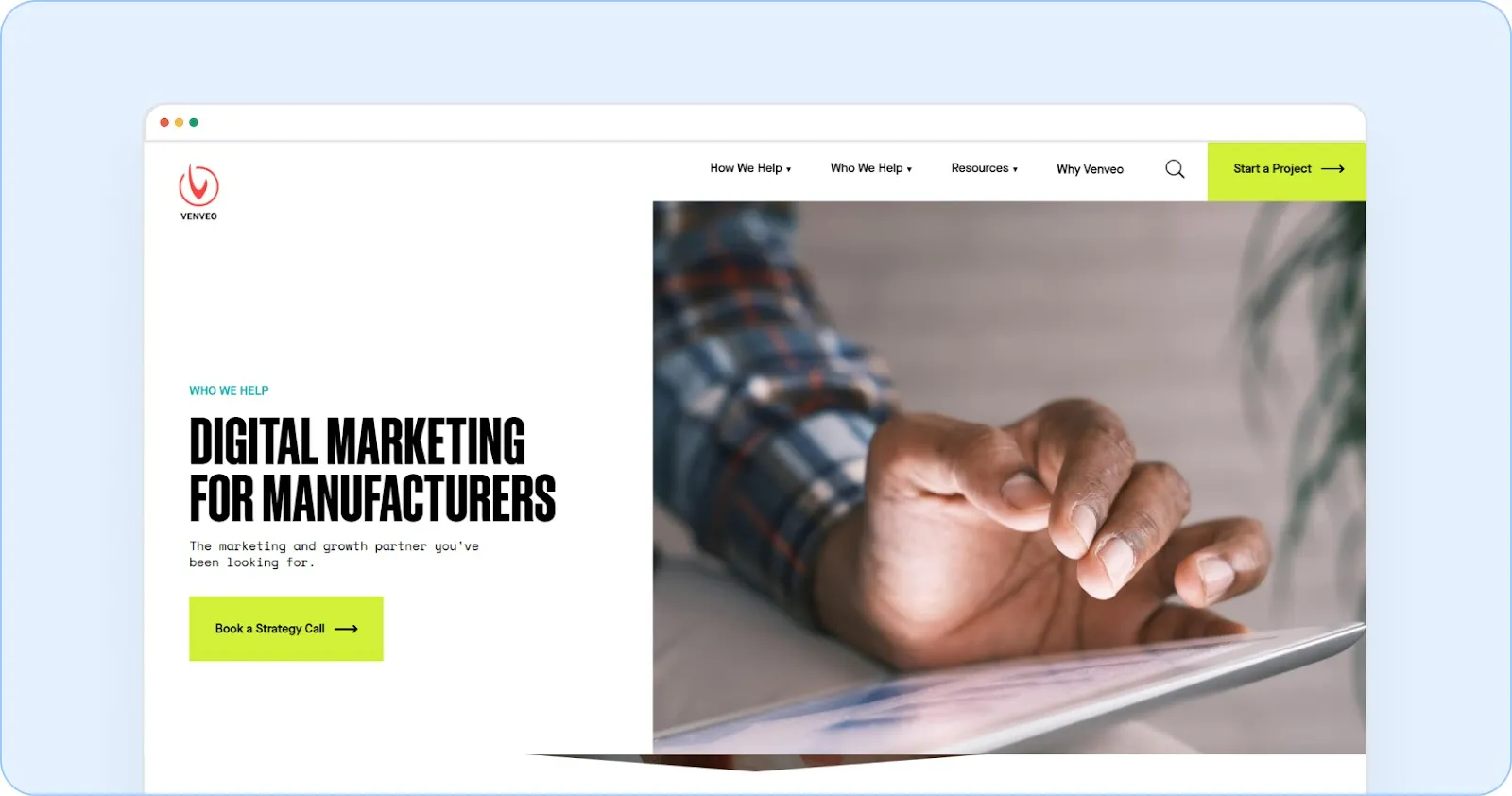
Venveo takes a personalized approach to digital marketing, offering tailored strategies that cater to A/V manufacturers’ specific needs. They focus on connecting businesses with the right audience and delivering long-term success.
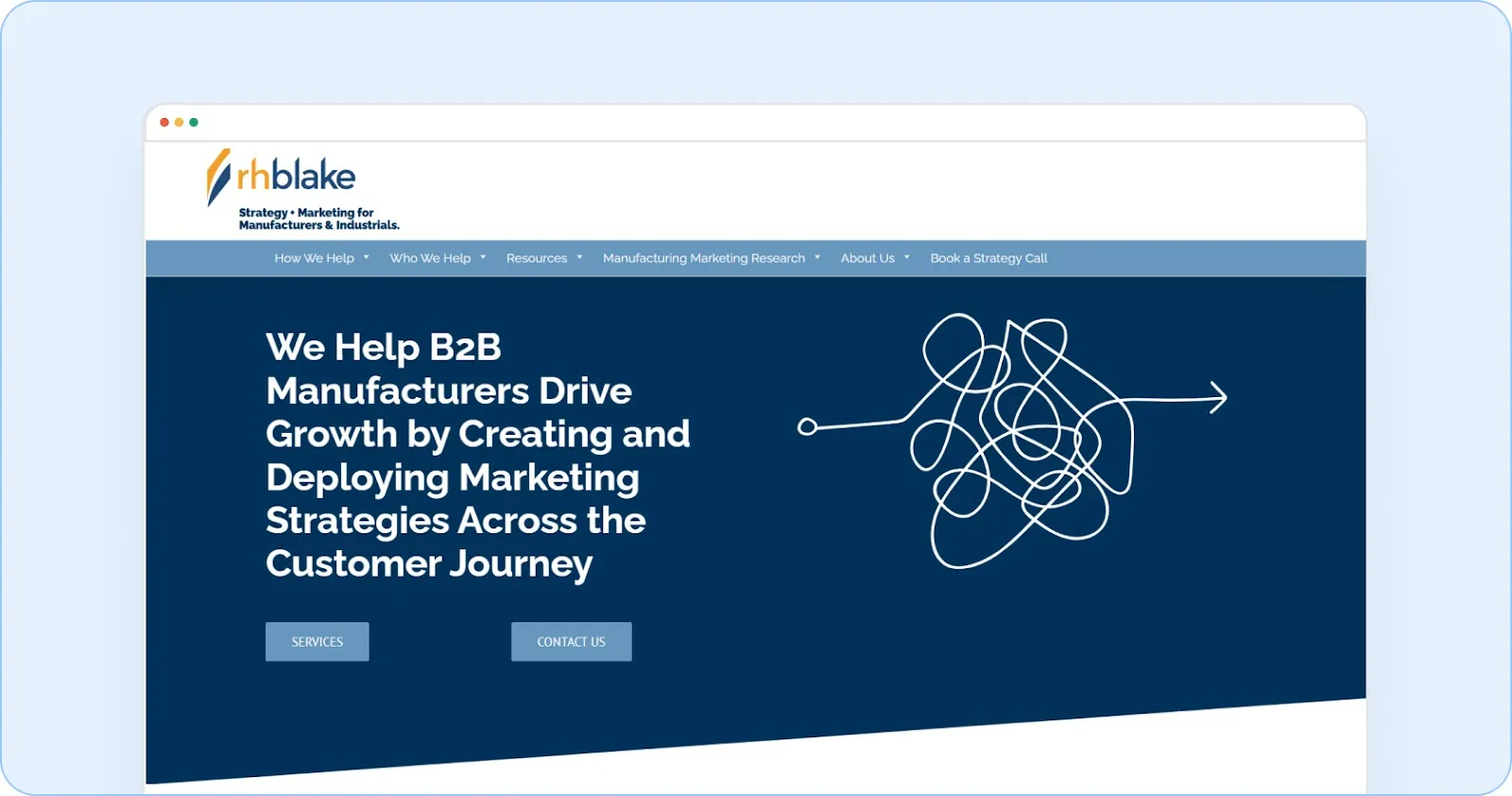
With over 30 years of experience, R.H. Blake offers a range of digital marketing services designed to help A/V manufacturers grow their online presence. Their offerings include SEO, paid advertising, and social media marketing.
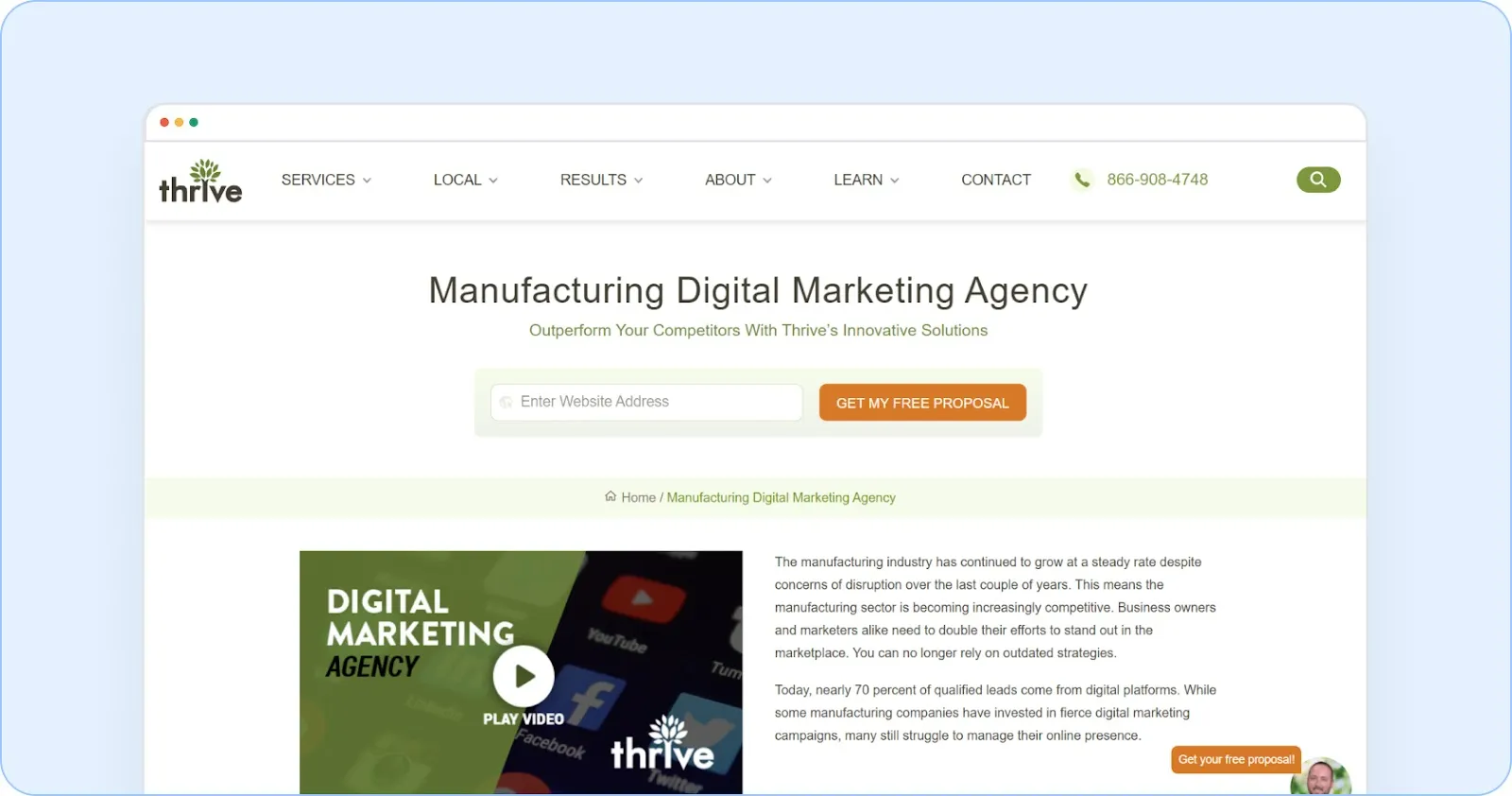
Thrive Internet Marketing Agency is known for its award-winning SEO, PPC, and social media services. Their digital strategies help A/V manufacturers succeed by optimizing their online presence and driving conversions.
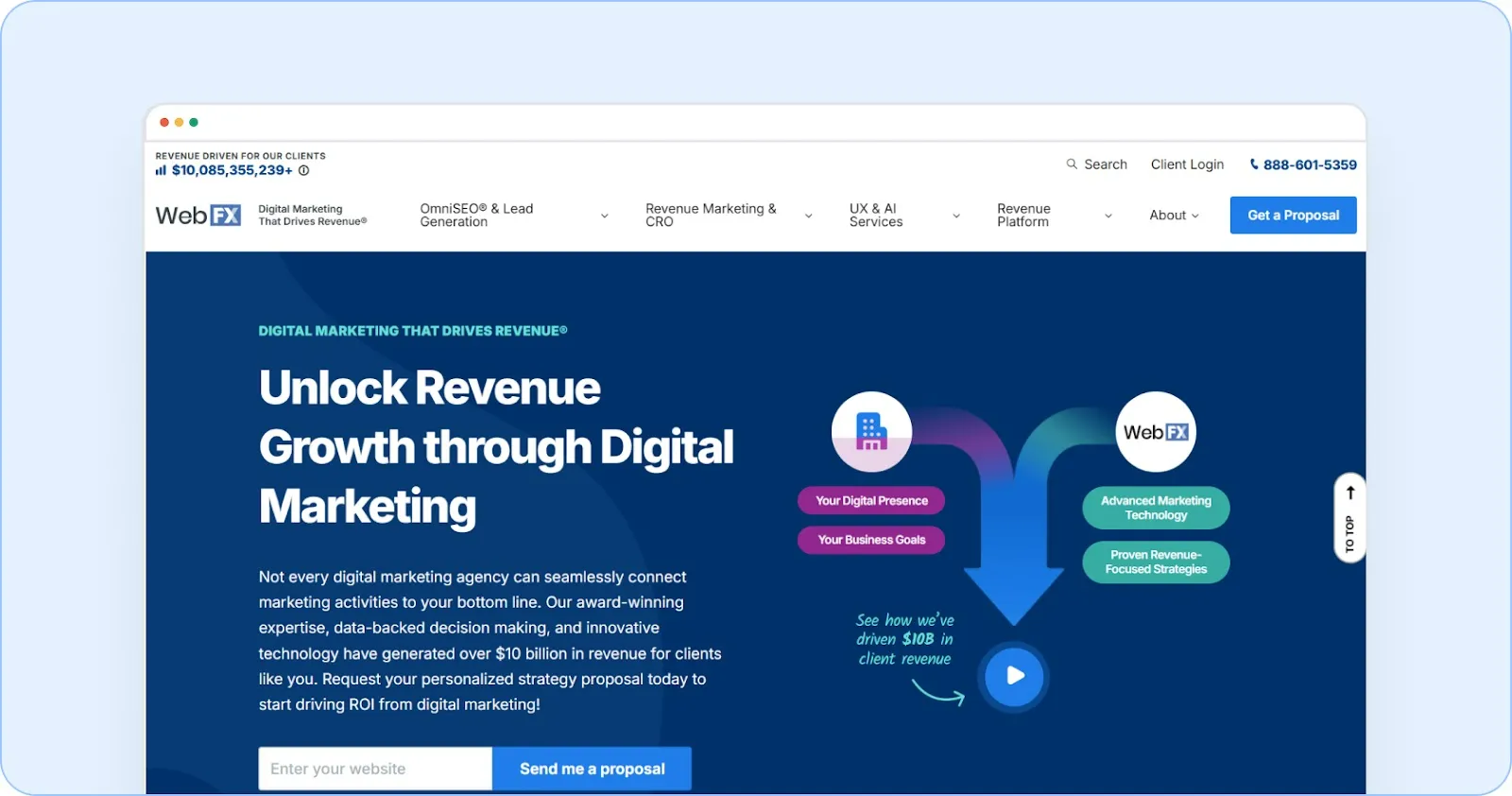
WebFX combines award-winning digital marketing expertise with data-driven strategies to help A/V manufacturers achieve tangible results. They specialize in SEO, PPC, and content marketing to generate high-quality leads and increase brand visibility.
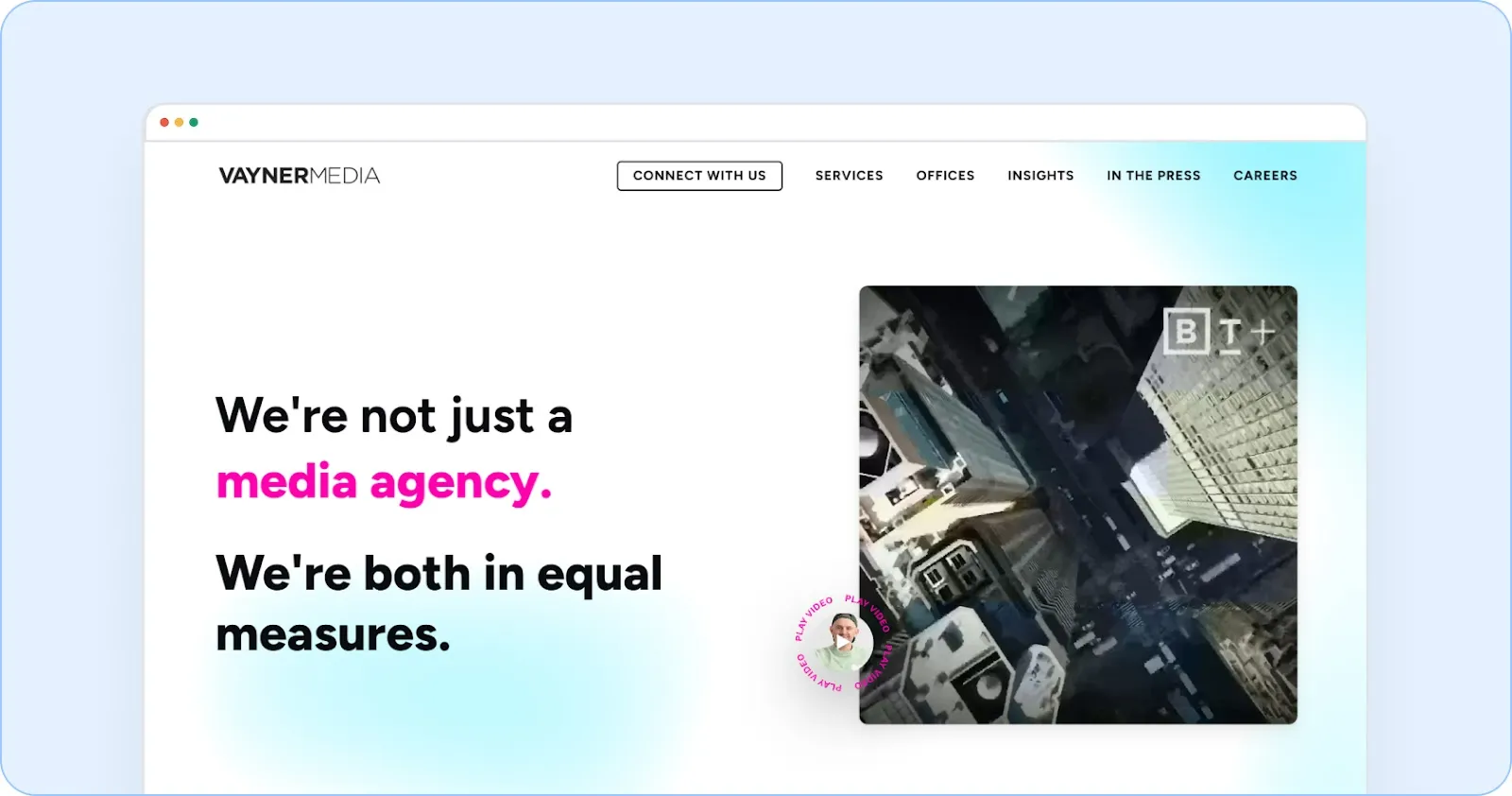
VaynerMedia offers integrated strategy, creative services, and media buying to help A/V manufacturers engage their target audience effectively. Their creative approach to digital marketing ensures your brand’s message stands out in a crowded marketplace.
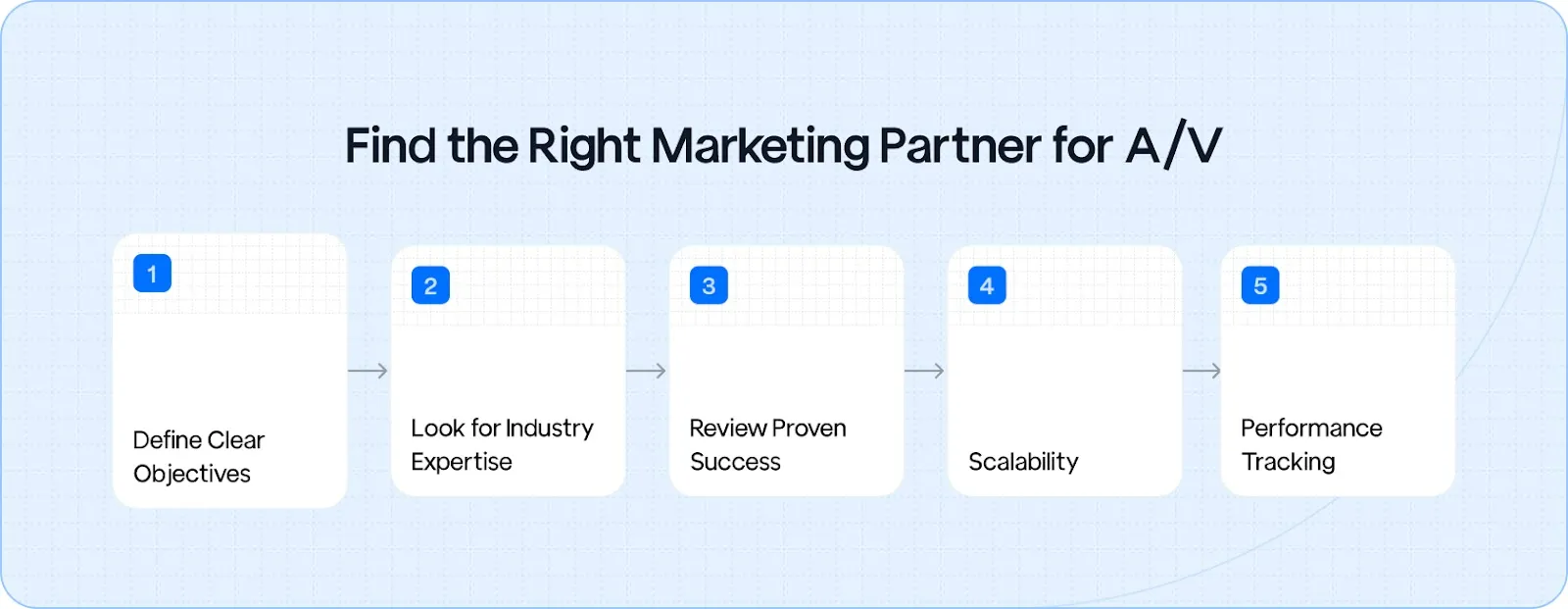
Choosing the right digital marketing agency for your A/V manufacturing business is about finding the right partner who truly understands your industry and its challenges.
A/V manufacturers face a unique set of marketing obstacles, including long sales cycles, technical product complexities, and niche customer needs. To ensure success, it’s critical to partner with an agency that has digital marketing expertise and a deep understanding of the A/V sector's intricacies.
Here’s what to keep in mind when choosing the right agency:
They'll have experience in overcoming technical marketing challenges, navigating long decision-making processes, and connecting with hard-to-reach, highly specific target audiences.
With consistent tracking, you can ensure that your marketing efforts are delivering the results you want and refine your strategy for continuous improvement.
Investing in digital marketing offers a significant return on investment for A/V manufacturers. By leveraging strategies like SEO, PPC, and targeted content marketing, agencies can help you achieve tangible results in key business areas such as lead generation, brand visibility, and customer engagement.
Here’s how digital marketing can yield an ROI:
With the right strategy, you can attract more attention from your target audience and gain higher visibility on search engines and social media platforms.
Selecting the right digital marketing agency is critical to your success as an A/V manufacturer. With personalized strategies, proven expertise, and data-driven results, the right agency can transform your marketing efforts into measurable growth.
By clarifying goals, understanding your industry’s unique needs, ensuring scalability, and tracking performance, the right team helps you stay ahead in a competitive market.
Key Takeaways:
Q1. What services does a digital marketing agency for A/V manufacturers offer?
A1: A digital marketing agency for A/V manufacturers typically offers services such as SEO, PPC advertising, content marketing, lead generation, and social media management. These services are tailored to attract qualified leads, increase brand visibility, and optimize conversions for A/V manufacturers.
Q2. How do I know if a digital marketing agency understands A/V manufacturing?
A2: Look for agencies with experience in the A/V industry. Check case studies, testimonials, and their knowledge of A/V-specific challenges such as long sales cycles and technical product marketing. An agency familiar with your industry will be able to create specialized strategies that align with your business goals.
Q3. What’s the ROI of digital marketing for A/V manufacturers?
A3: The ROI of digital marketing for A/V manufacturers includes increased lead generation, higher brand visibility, improved customer engagement, and better conversion rates. Agencies measure success through detailed performance analytics, ensuring every marketing dollar spent contributes to measurable growth.
Q4. Can a marketing agency help with long sales cycles typical in A/V manufacturing?
A4: Yes, a specialized marketing agency can help by creating strategies that nurture leads through the extended sales cycle. Through content marketing, email campaigns, and retargeting, they keep prospects engaged until they’re ready to make a purchase decision.
Q5. How do digital marketing agencies measure the success of their campaigns for A/V manufacturers?
A5: Agencies measure success through metrics like lead quality, conversion rates, website traffic, and engagement levels. They provide detailed reports and use data analytics to refine strategies, ensuring continuous optimization and a strong return on investment.
Q6. How can I ensure that my digital marketing agency delivers results for my A/V business?
A6: Choose an agency with proven expertise in A/V manufacturing. Ask for case studies and detailed reports on past campaign results. Ensure they provide consistent performance tracking and are transparent about their strategies to ensure they align with your business goals.
Q7. What makes Gushwork different from other digital marketing agencies for A/V manufacturers?
A7: Gushwork stands out for its deep expertise in the A/V manufacturing sector. They offer tailored strategies specifically designed for A/V brands, focusing on attracting high-quality leads, improving visibility, and maximizing ROI through SEO, PPC, and content marketing, all while understanding the unique challenges of A/V manufacturing.
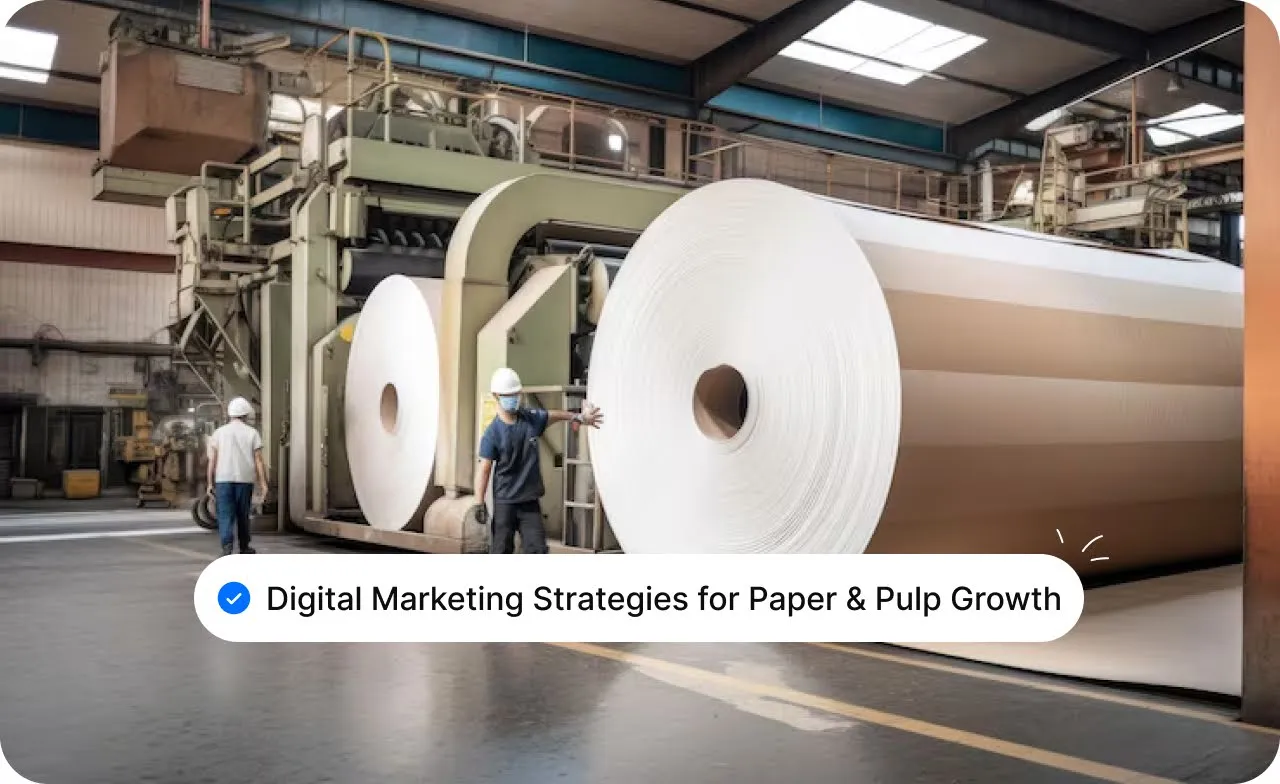
Are you tired of investing in digital marketing strategies that seem to generate clicks but fail to bring in qualified leads for your mill?
In the paper and pulp industry, it's not enough to simply show up online. If you're still relying on generic PPC ads and social media posts, you're missing the mark.

Procurement teams, packaging buyers, and global distributors don’t want fluff; they want measurable results, like certified products, sustainability metrics, and on-time deliveries. If your digital presence doesn’t address these specific concerns, you risk losing deals before they even hit your inbox.
This guide is for paper and pulp manufacturers who want to stop wasting marketing spend and start attracting high-value leads that convert into long-term contracts.
Your mill’s website is where leads start coming in. It should work as your best sales engineer, giving potential buyers the exact details they need, right when they need them.
This is where your first impression is made, so getting it right is crucial.
Make sure your website is set up to provide easy access to the most important details for your customers:
Procurement teams are looking for suppliers who make information easy to access and understand. If they have to search for key details like specs, certifications, or pricing, they may skip over your site for one that makes these things more straightforward.
Transparency on your website means buyers won’t waste time digging through pages. Instead, they’ll move forward with a quote or inquiry faster.
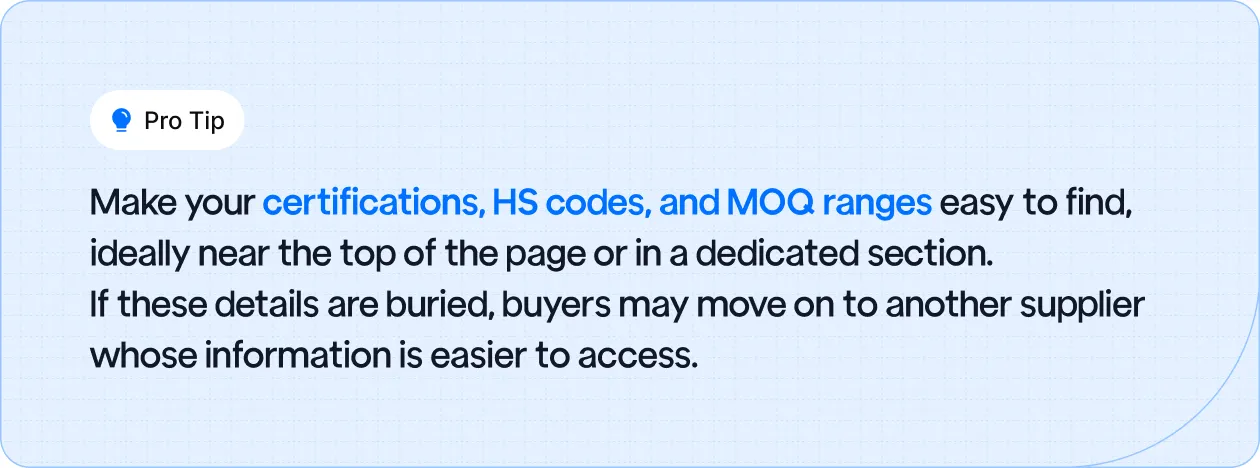
When procurement teams are searching for paper and pulp suppliers, they want to know exactly what they’re getting.
Tissue-based paper, linerboard, and recycled pulp all require an understanding of the specifications, compliance, and sustainability of the product.
Content that speaks directly to these needs can push your mill from the “maybe” list to the “preferred supplier” list.
Procurement teams don’t have time to dig through pages to find product data. The easier you make it for them to assess your products, the quicker they can move forward with their decision.
Offering transparent, data-backed content shows you’re reliable and confident in your product’s performance, and this builds trust with potential buyers.
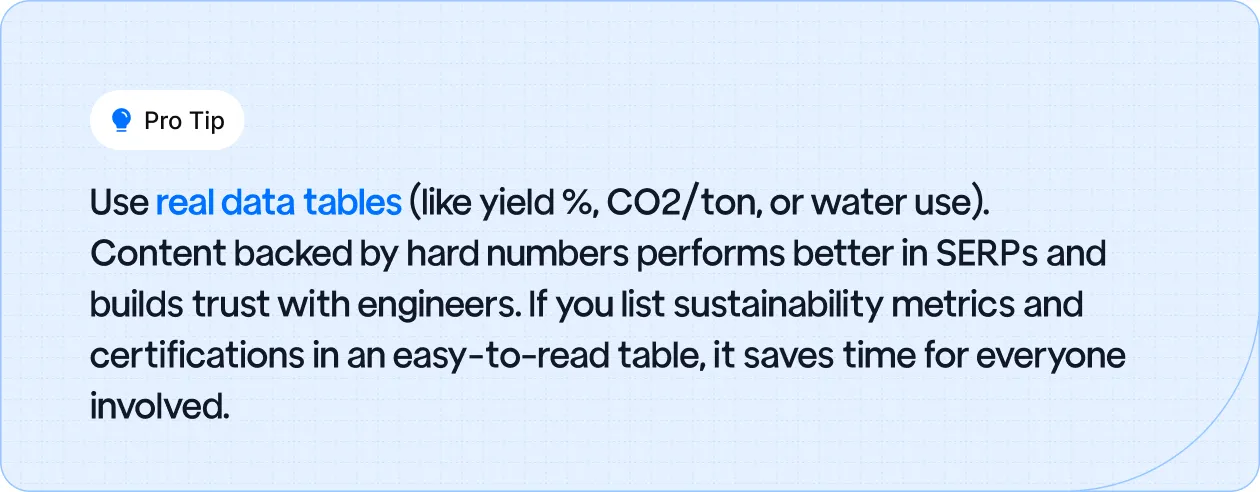
Broad digital ads are rarely effective for the paper and pulp industry. In a sector where suppliers are often competing for large contracts and long-term partnerships, a scattershot approach won’t cut it.
Instead, Account-Based Marketing (ABM) targets specific high-value buyers with tailored campaigns that speak directly to their needs.

Each has a different focus, so your messaging needs to reflect that. For example, procurement cares about price and delivery, R&D is interested in performance and innovation, and sustainability teams want to see eco-friendly certifications and data.
Procurement managers, supply chain professionals, and packaging experts are all actively engaging on LinkedIn. If you’re not putting your mill in front of them on this platform, you’re already behind.
LinkedIn has become a digital trade show booth where decision-makers go to source new suppliers.
When potential buyers search for terms like “FSC kraft supplier” or “tissue base paper exporter,” your mill should be right there at the top of the search results.
These high-intent search terms are opportunities that shouldn’t be wasted on vague or irrelevant ads.
Here’s how to pick and use these terms effectively:

In the paper and pulp industry, deals often take months, sometimes even longer, to close. Automated, value-packed emails ensure your mill stays top of mind during long procurement cycles.

In the paper and pulp industry, a buyer’s trust is often won long before they visit your mill. Virtual plant tours and quick compliance videos are effective tools that can demonstrate your quality and transparency, even when buyers are halfway across the world.
Buyers want to feel confident about your mill’s operations and product quality, but they can’t always afford or schedule an in-person visit. That's where virtual tours and video content come in.
Sustainability is a major purchasing factor for paper and pulp buyers. But greenwashing won’t get you very far.
What will work is hard data, like CO2 emissions per ton of product, water recycling rates, and detailed certifications.

Global buyers don’t have time to search for you; they expect you to be visible when they need you. The export markets for paper and pulp products are vast, but if your mill isn’t discoverable in Europe, the GCC, or Southeast Asia, you could be missing out on substantial opportunities.
Export SEO ensures your mill appears when buyers are searching for suppliers in their specific region.
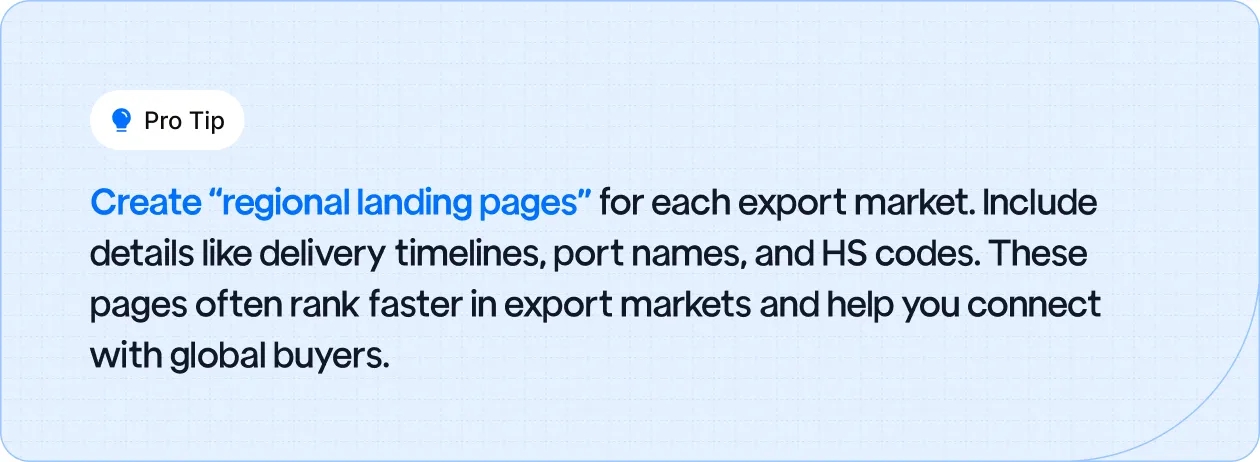
Trade shows are a key way to meet potential buyers, but the real work begins after the event. Leads gathered from trade shows are typically unqualified until you nurture them through email marketing, case studies, and tailored follow-ups.
Digital marketing makes sure your mill doesn’t lose touch with leads once they’ve left the show floor.
Likes and impressions don’t pay the bills. Lead quality and conversion rates are the true indicators of how well your digital marketing is performing. Paper and pulp manufacturers need to track the KPIs that move the needle on sales.

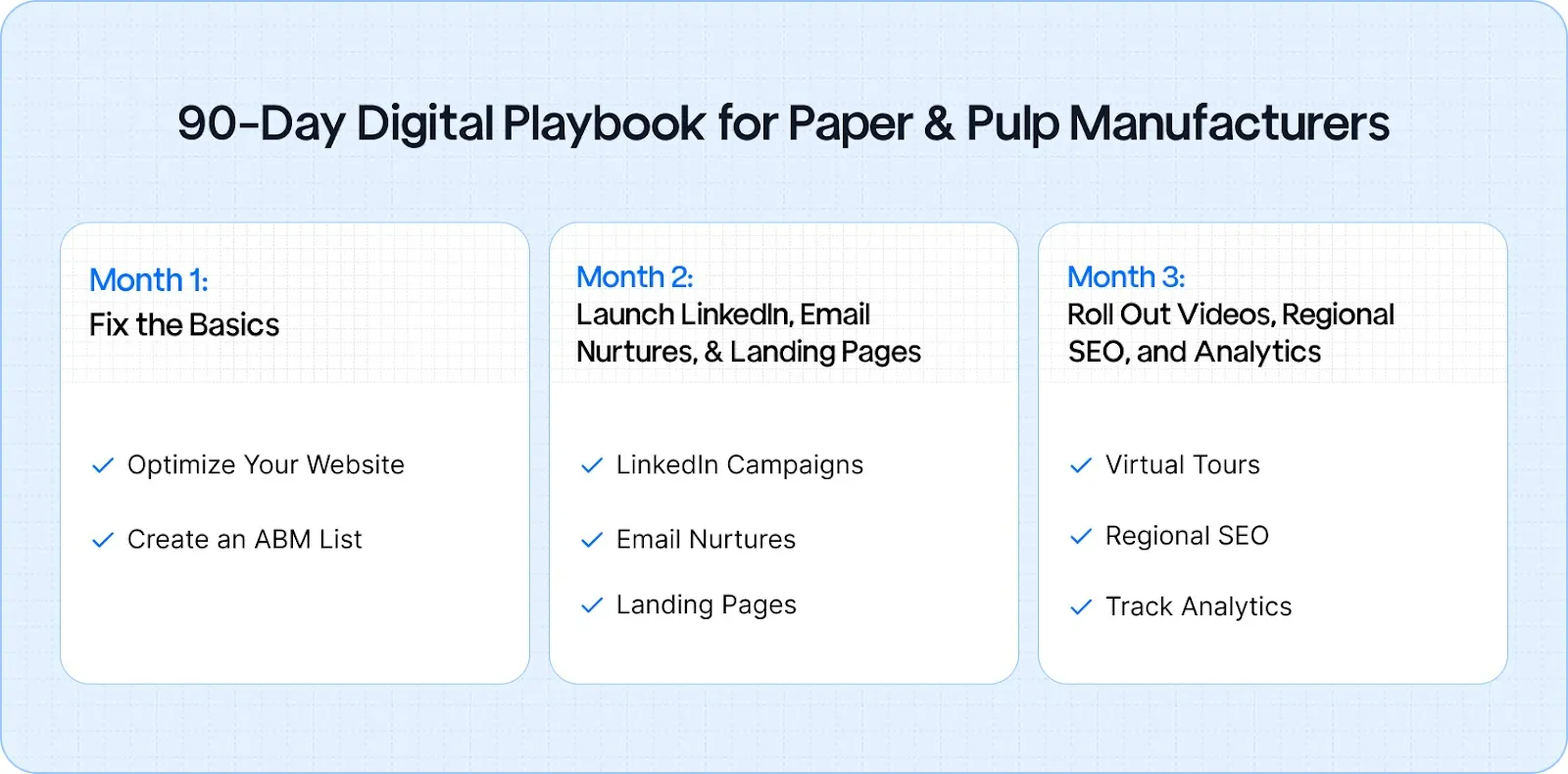
Getting your mill’s digital marketing efforts off the ground can seem overwhelming. But with a focused 90-day plan, you can quickly build momentum and start seeing results.
This roadmap is designed to help paper and pulp manufacturers grow their online presence and start generating leads fast.
Digital marketing has moved from a luxury to a necessity for pulp & paper mills. Without it, staying visible and trusted in an increasingly competitive marketplace is nearly impossible. It’s time to shift from being an invisible supplier to a trusted partner in your industry's eyes.
Gushwork understands the unique challenges you face. Let us help you implement these proven strategies without draining your resources.
Q1. Why is digital marketing crucial for paper and pulp manufacturers?
A1. Digital marketing helps paper and pulp manufacturers stay visible and relevant to buyers who increasingly rely on online research before making decisions. It enables mills to showcase their capabilities, certifications, and sustainability efforts, improving lead generation and conversion rates.
Q2. How can SEO help paper and pulp manufacturers attract the right buyers?
A2. SEO ensures your mill ranks for targeted, high-intent keywords such as "FSC kraft paper supplier" or "tissue base paper manufacturer." This helps attract procurement managers and buyers who are actively looking for certified, sustainable, and high-quality products in your niche.
Q3. What is Account-Based Marketing (ABM) and how can it help paper and pulp mills?
A3. ABM targets specific, high-value buyers with personalized campaigns. For paper and pulp mills, ABM focuses on top accounts in industries like tissue manufacturing or packaging, allowing tailored messaging based on their needs, such as sustainability certifications or product performance.
Q4. How important is mobile optimization for paper and pulp manufacturing websites?
A4. Mobile optimization is essential, as many industrial buyers research suppliers on their smartphones or tablets. A mobile-friendly site ensures quick access to essential product information, technical specifications, and contact forms, improving lead conversion rates.
Q5. Can LinkedIn be effective for generating leads in the paper and pulp industry?
A5. Yes, LinkedIn is a powerful platform for reaching decision-makers in procurement, packaging, and sustainability. By sharing content about your mill’s capabilities, sustainability efforts, and product innovations, you can engage key industry professionals and increase visibility.
Q6. How can virtual tours help paper and pulp manufacturers build buyer trust?
A6. Virtual tours allow potential buyers to experience your mill's processes and capabilities without visiting in person. By showcasing your operations, certifications, and quality control processes, you build transparency and trust, which are crucial in securing long-term contracts.

You know the frustration: pouring thousands into marketing campaigns only to attract leads who don’t understand the nuances of your metal fabrication business. Engineering teams aren’t impressed by flashy brochures; they care about weld integrity, CNC precision, and custom tolerances.
Procurement managers won’t respond to generic pitches; they need proof you can meet project specifications on time, every time. Traditional marketing tactics often leave you shouting into a void, wasting time and budget on contacts who will never convert.

This guide is for metals manufacturers who need a marketing strategy that targets the exact buyers who value precision, reliability, and technical expertise.
Digital disruption is no longer optional in metals manufacturing. Buyers now research suppliers online, compare multiple vendors, and often make decisions before ever speaking to a salesperson.
Companies embracing digital tools are more visible, more credible, and able to engage prospects faster.
Why It Works:
Digital marketing allows you to:
Actionable Tip: Develop a digital marketing plan that includes:
If buyers can’t find you online, they’ll find your competitors. SEO ensures your company appears in search results when decision-makers look for niche services like “CNC metal cutting” or “stainless steel fabrication.”
Why It Works:
Actionable Tip:
Consider writing long-form content like “How to Reduce Material Waste in CNC Milling” or “Best Practices for Custom Steel Fabrication” to capture buyers searching for solutions, not just products.
Engineers and procurement teams want actionable insights. Content marketing positions your company as a trusted advisor rather than just another vendor.
Why It Works:
Actionable Tip:
Use downloadable resources like checklists or CAD templates that engineers can reference during internal discussions. This subtly builds authority while giving prospects something useful.
Social media is a tool for engagement, relationship-building, and thought leadership in metals manufacturing. LinkedIn, Twitter, and Instagram can help you reach the right professionals.
Why It Works:
Actionable Tip:
Use short videos or infographics that visually explain processes; these are often shared internally within engineering teams, increasing your organic reach.
Your website is your digital salesperson, working 24/7. For metal manufacturers, they need to communicate their capabilities clearly and persuade visitors to take action.
Why It Works:
Actionable Tip:
Use case-specific landing pages targeting different buyer personas (e.g., procurement vs. engineering) to guide visitors to relevant content quickly.
Not all leads are created equal. Lead scoring prioritizes prospects most likely to convert, helping your sales team focus on high-value opportunities.
Why It Works:
Actionable Tip:
Integrate lead scoring with marketing automation so nurturing workflows can continue for lower-scoring leads without manual effort.
Also Read: The Best Marketing Methods for Small Manufacturers: 11 Proven Strategies for Success
Paid campaigns like PPC and LinkedIn ads help metals manufacturers target the exact decision-makers searching for their services.
Why It Works:
Actionable Tip:
Create landing pages specifically for ad campaigns to increase conversion rates and track ROI more accurately.
Email marketing nurtures prospects and maintains relationships over long sales cycles, which is critical in metals manufacturing.
Why It Works:
Actionable Tip:
Automate triggered emails based on user behavior, like downloading a brochure or attending a webinar, to maintain engagement without extra manual effort.
In-person interactions allow prospects to see your capabilities and build trust, something digital alone can’t achieve.
Why It Works:
Actionable Tip:
Combine live events with digital campaigns, share photos, video snippets, and post-event summaries to extend engagement beyond the show floor.
Without data, marketing is guesswork. Analytics reveal which campaigns perform and where you should focus next.
Why It Works:
Actionable Tip:
Visualize data with dashboards to share insights across your team. Highlight top-performing campaigns, then double down on strategies that work.
In many metals manufacturing companies, sales and marketing often work in silos, both aiming for growth but rarely speaking the same language.
Marketing might be producing campaigns, emails, and trade show content, while sales struggles to follow up on leads that weren’t qualified or nurtured properly. The result?
Consider a typical scenario: an engineer is evaluating suppliers for a complex CNC project. Marketing sends a general newsletter highlighting your capabilities, while sales calls are made without knowing what the prospect has already seen.
Mixed messages confuse the buyer, making competitors who present a cohesive experience far more appealing.
Today’s industrial buyers research suppliers on smartphones, tablets, and laptops. If your website doesn’t load correctly or display important content properly on mobile devices, you could be losing qualified leads before they even get in touch.
A mobile-optimized website signals professionalism and reliability to engineering and procurement teams who expect quick access to technical details, specifications, and contact options.
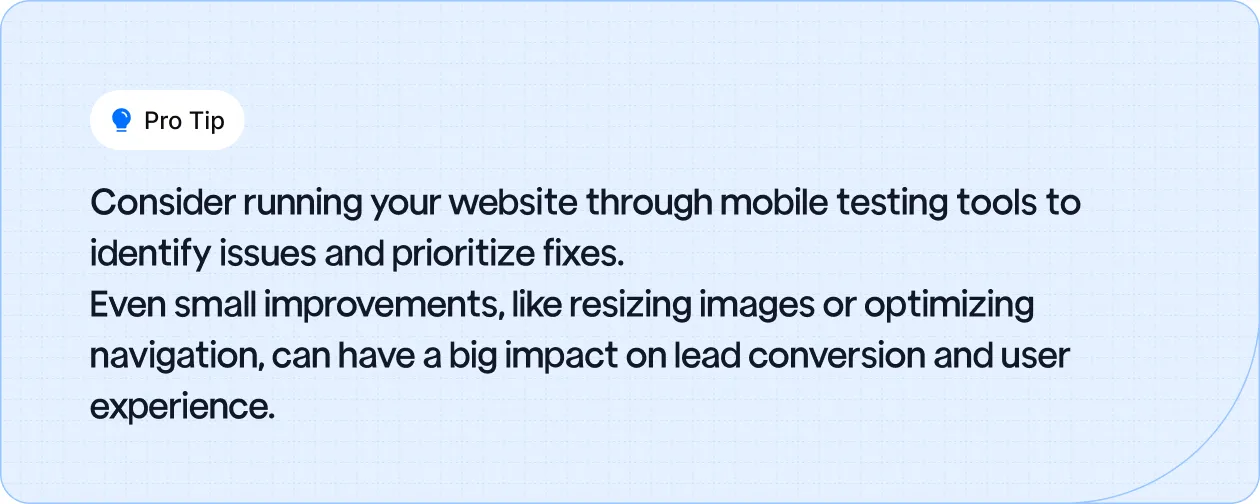
The future of metals manufacturing marketing is embracing a digital-first mindset, building meaningful relationships, and making data-driven decisions that generate measurable results.
Success comes from engaging the right buyers at the right time, providing educational content, and ensuring every interaction reflects your expertise.
Many manufacturers feel frustrated with wasted ad spend, scattered campaigns, and unqualified leads that never convert. A DIY approach to marketing isn’t enough to compete in today’s digital and technical landscape.
Gushwork understands these challenges and integrates AI-powered tools to streamline campaigns, optimize lead nurturing, and drive measurable growth.
Q1. What is marketing for metals manufacturing, and why is it different from general B2B marketing?
A1. Marketing for metals manufacturing focuses on reaching technical buyers like engineers, procurement teams, and project managers. Unlike generic B2B marketing, it emphasizes demonstrating technical expertise, showcasing custom fabrication capabilities, and addressing complex specifications, tolerances, and project deadlines.
Q2. How can metal manufacturers generate qualified leads without wasting budget on unqualified prospects?
A2. By combining targeted SEO, lead scoring, and content marketing, metals manufacturers can attract prospects who actively search for niche services like CNC cutting or custom steel fabrication. Prioritizing high-value leads ensures sales teams focus on prospects most likely to convert, reducing wasted ad spend.
Q3. Which digital channels are most effective for metals manufacturing marketing?
A3. Key channels include:
Q4. How important is a mobile-optimized website for metals manufacturers?
A4. Extremely important. Engineering and procurement teams often research suppliers on mobile devices. A responsive website ensures easy access to product specs, project galleries, RFQs, and technical resources, which improves lead conversion and strengthens credibility.
Q5. Can trade shows still drive leads in the digital age for metal fabrication businesses?
A5. Yes. Trade shows like FABTECH or MetalCon allow manufacturers to demonstrate capabilities in real-time, build trust with buyers, and collect high-quality leads. Combining in-person events with digital follow-ups extends engagement and maximizes ROI.
Q6. How can metal manufacturers measure the effectiveness of their marketing campaigns?
A6. Analytics tools like Google Analytics, HubSpot, or Marketo help track website traffic, lead conversions, campaign performance, and content engagement. Regular review of these metrics allows manufacturers to optimize campaigns, refine strategies, and improve ROI.
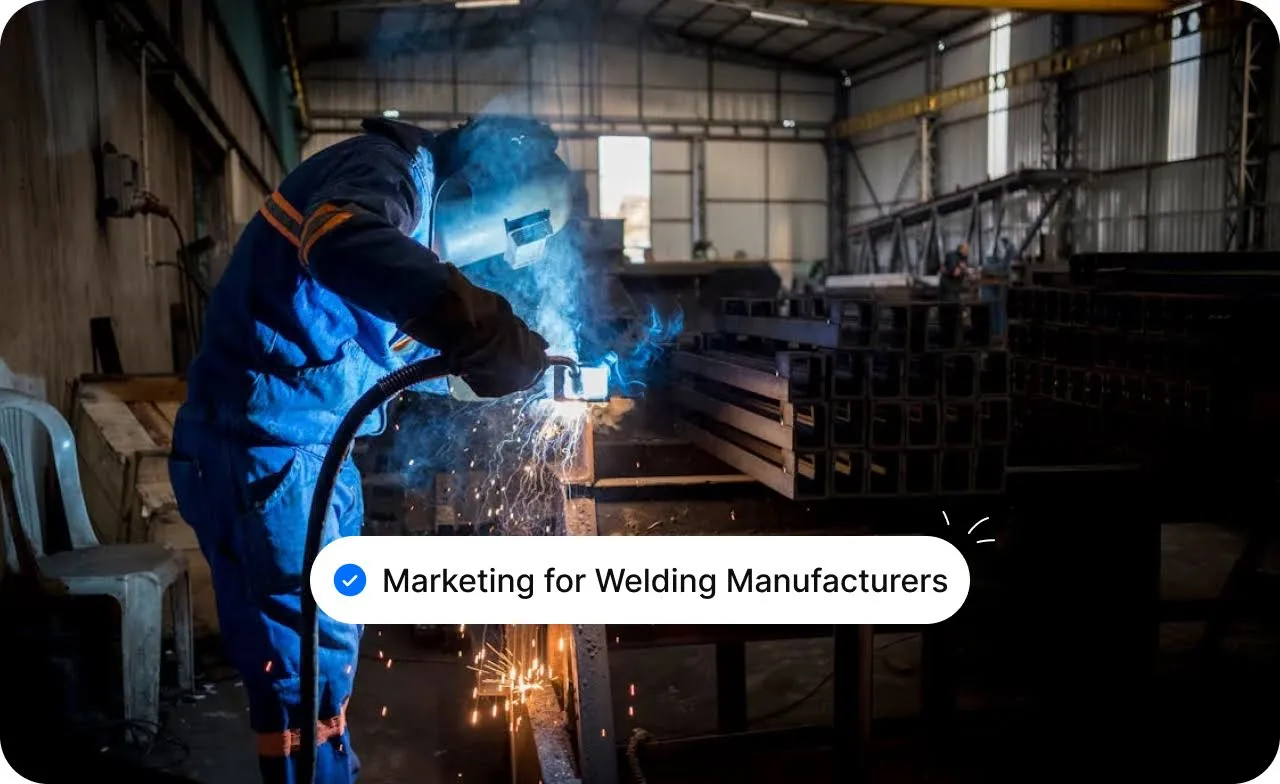
Have you ever noticed how people only call you after they have already decided you "look right" for the job?
That choice rarely comes from a single conversation anymore. It comes from what they see when they search your company name, browse your website, or scan your welding capabilities online. They judge the quality of your work before they hear your voice. And for many welding manufacturers, that moment is where good opportunities quietly slip away.
Marketing in welding is about making your skill, precision, and reliability visible to buyers who care about getting it right the first time.
This guide walks through how welding manufacturers can build marketing that boosts sales, strengthens reputation, and supports long-term scale.
Marketing for welding manufacturers works best when it mirrors how your buyers think and decide. They are not looking for slogans. They are looking for confidence. They want to know you understand their specs, their timelines, and their quality expectations.
Strong welding marketing focuses on a few core realities:
Finished projects, weld quality, process documentation, and real applications carry more weight than sales language.
Clear explanations of your capabilities, materials, and standards eliminate hesitation.
The easier it is to find and understand your expertise, the more likely buyers are to shortlist you.
When your messaging matches your actual work, it strengthens belief in your reliability.
When marketing for welding manufacturing reflects the same care and precision you apply on the shop floor, it creates a steady flow of clients who already respect your work before the first conversation even begins. That is what turns marketing from an afterthought into a growth engine for welding manufacturers.
The real challenge in running a welding shop is getting the right customers to notice your business.
Many welding manufacturers still wait for referrals or repeat contracts, but buyers today search online, compare options, and choose based on credibility.
If your company doesn’t appear in those searches, you lose opportunities.

Welding manufacturers face hurdles when it comes to winning new business:
Marketing is more than a support function; it drives measurable results for manufacturers.
The shop floor isn’t the only place business happens anymore; buyers start their search online. If your welding business isn’t visible there, you’re losing contracts before you even get a chance to bid.

Building a strong online presence ensures potential clients can find you, trust you, and contact you.
Search engines are often the first stop for buyers looking for welding services. With the right SEO approach, your shop can show up at the top when they search.
Your website is often the first impression of your shop. A cluttered, outdated site can turn buyers away even before they see your work.
Once your shop is visible online, the next step is amplifying your brand where clients spend their time, social media.
Different platforms serve different goals. Understanding what to post and where helps you reach the right people.
LinkedIn: Ideal for B2B connections. Use it to connect with plant managers, procurement officers, and contractors who often need welding services. Share case studies, project highlights, or technical know-how to position your shop as an authority.

Consistency and authenticity beat fancy production every time. Buyers want to see real work, real results, and real people.

Social media builds visibility and trust. In an industry where many buyers choose based on reputation, your online presence can act as proof of quality.
With social media making your brand visible and trusted, the next step is to drive faster, more targeted results through paid advertising.
Think of content marketing as your shop’s steady welding arc; it builds trust slowly, but the bond it creates lasts for years. Unlike quick ads, content keeps working long after you’ve posted it.
Ways to make it work:

Content builds authority. Now, let’s talk about how to turn those readers into loyal, paying clients.
Winning a job is one thing. Turning that job into a long-term contract is where the real profit lies. The strongest welding shops treat relationships like assets.
Here’s how to make it happen:
1. Customer service excellence: Personalize your follow-up. Example: one welding shop turned a one-off pipe repair into a 3-year contract simply by checking in regularly.
2. Testimonials & reviews: Nothing beats real client feedback. Ask for reviews on Google or LinkedIn and proudly display them on your site.

3. Loyalty programs: Reward repeat business. Offer referral discounts or early access to scheduling slots for top clients.

With stronger relationships, you’ll want to track what’s really working behind the scenes.
Think of analytics like the gauges on your welding machine. They tell you if things are on track or if something needs adjusting.
Metrics to track:
Tools to use:

Once you know what’s working, it’s time to shift gears and bring in fast results with PPC ads.
Sometimes you can’t wait months for SEO to kick in. That’s where PPC steps in; it’s like striking an arc that produces instant heat.
Your best options:

PPC brings fast leads, but to play the long game, your content is what keeps your business growing year after year.
Success in welding is about making sure the right clients can find you, trust you, and choose you over the competition.
The shops that grow sustainably are the ones treating marketing as a strategy, not an afterthought.
If you’re still relying on referrals or waiting for calls to come in, you will keep struggling with inconsistent jobs and wasted time on unqualified leads.
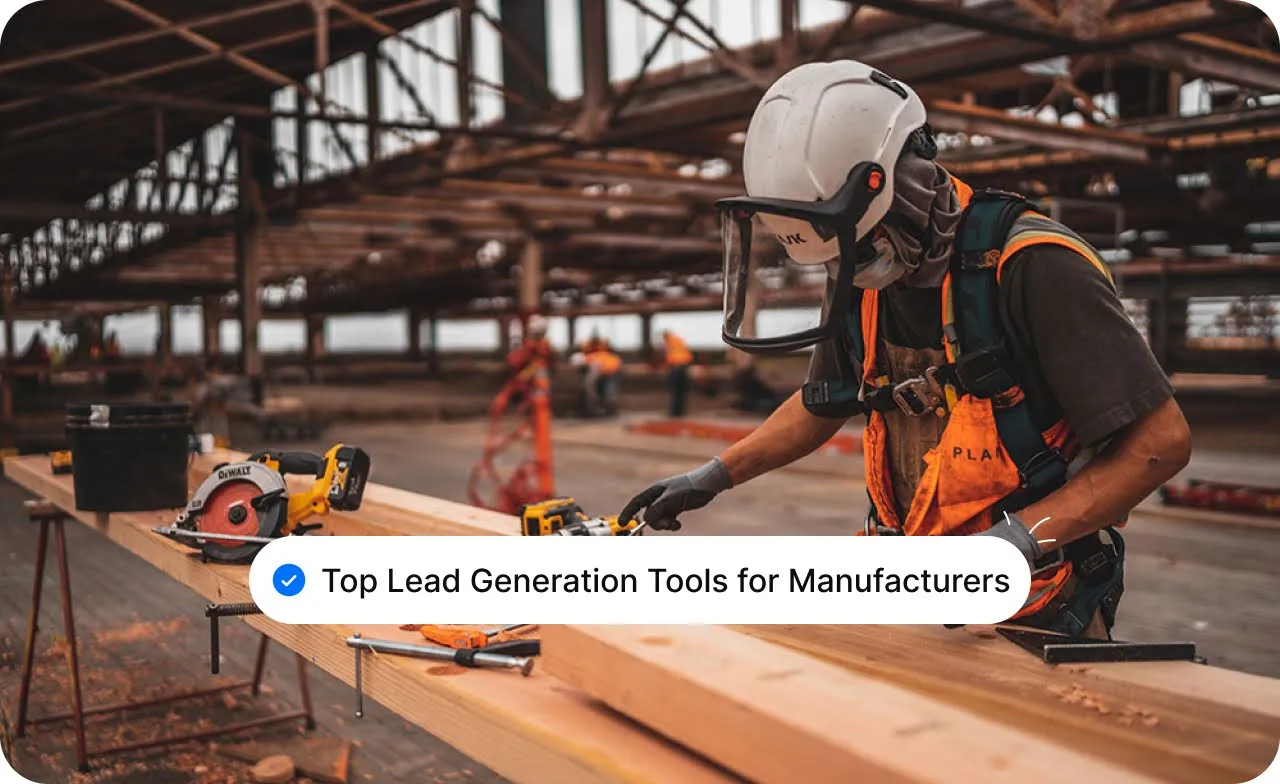
Construction product manufacturers often rely on relationships, referrals, and long sales cycles. But today’s buyers look online first. Contractors, architects, and project managers want quick answers, clear specs, and a shortlist of suppliers they can trust. If your products don’t show up where they search, they move on to whoever does.
That’s where the right lead generation platforms help. They put your products in front of active buyers, connect you to real projects, and give you steady visibility without adding more work to your plate. For manufacturers trying to grow in a competitive market, these platforms make a real difference.
In this blog, you’ll find seven platforms that consistently help construction product manufacturers reach qualified buyers and create more dependable lead flow.
Lead generation in the construction space is all about getting your products in front of the people who make project-driven decisions. Instead of chasing broad audiences, you focus on reaching out to specific buyers who are actively researching materials, equipment, or solutions for upcoming jobs.
For manufacturers, strong lead generation:
These top platforms are built around how real construction buyers search for products. They gather project data, list trusted suppliers, and make it easier for contractors, architects, and builders to compare options. Each one gives manufacturers a practical way to stay visible, get in front of active projects, and bring in leads that are already warmed up.

Gushwork offers a fully integrated system that incorporates AI to streamline the lead generation process for construction product manufacturers.
Unlike traditional methods that rely on manual searching or generic lead lists, Gushwork uses advanced AI to automate lead discovery, qualification, and outreach, ensuring that manufacturers connect with the most relevant leads based on project data.
Construction product manufacturers can rely on Gushwork to connect with qualified contractors, architects, and developers who are actively searching for construction products, ensuring they find the right leads without wasting time on irrelevant contacts.
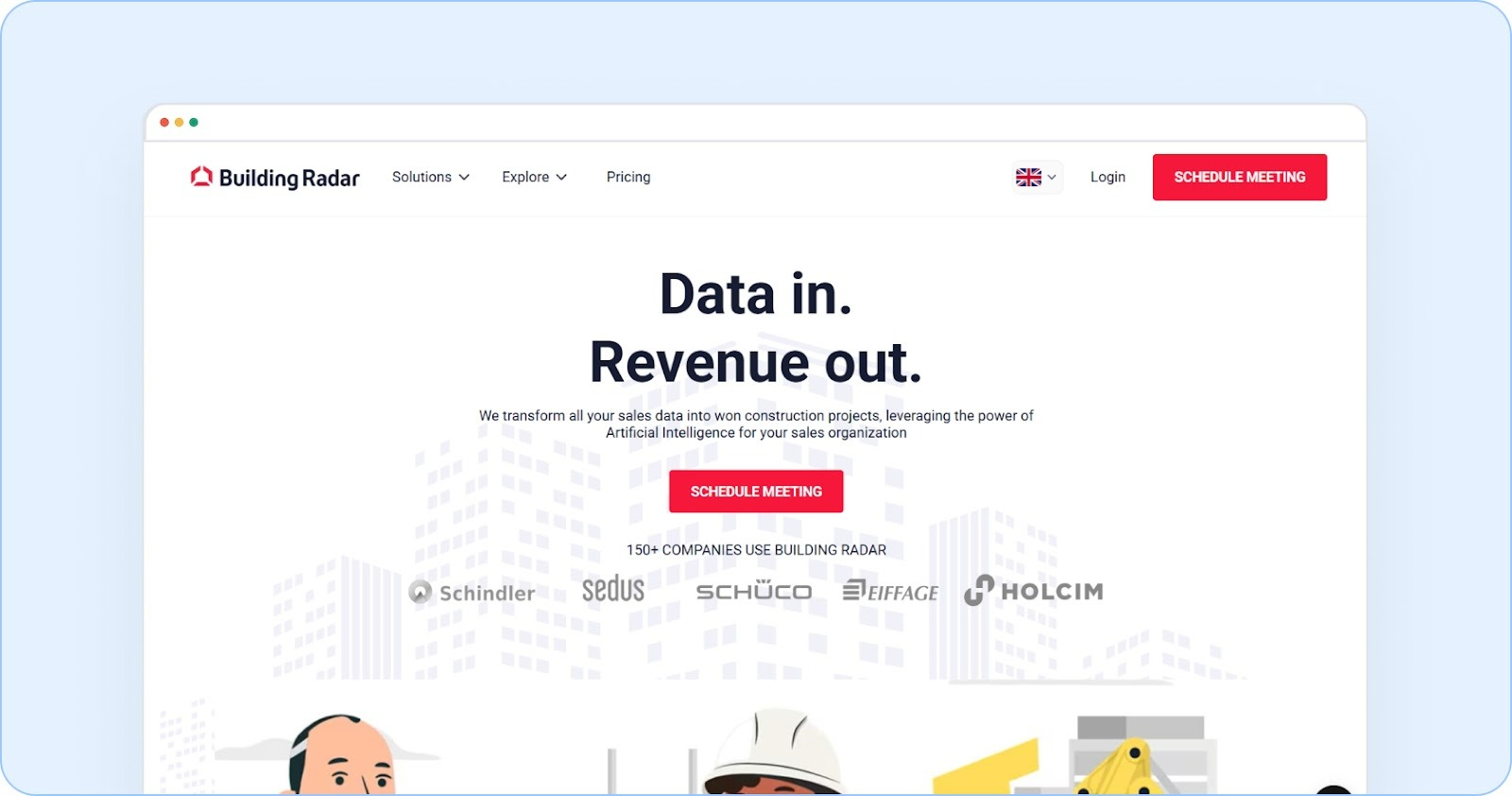
Building Radar takes lead generation to the next level by leveraging AI to surface construction projects early. For manufacturers, this tool offers a competitive advantage by identifying new projects and providing timely alerts about opportunities that match your criteria.
Manufacturers can use Building Radar to find large-scale commercial projects that are a perfect fit for their construction products, allowing them to bid early and gain a competitive edge.
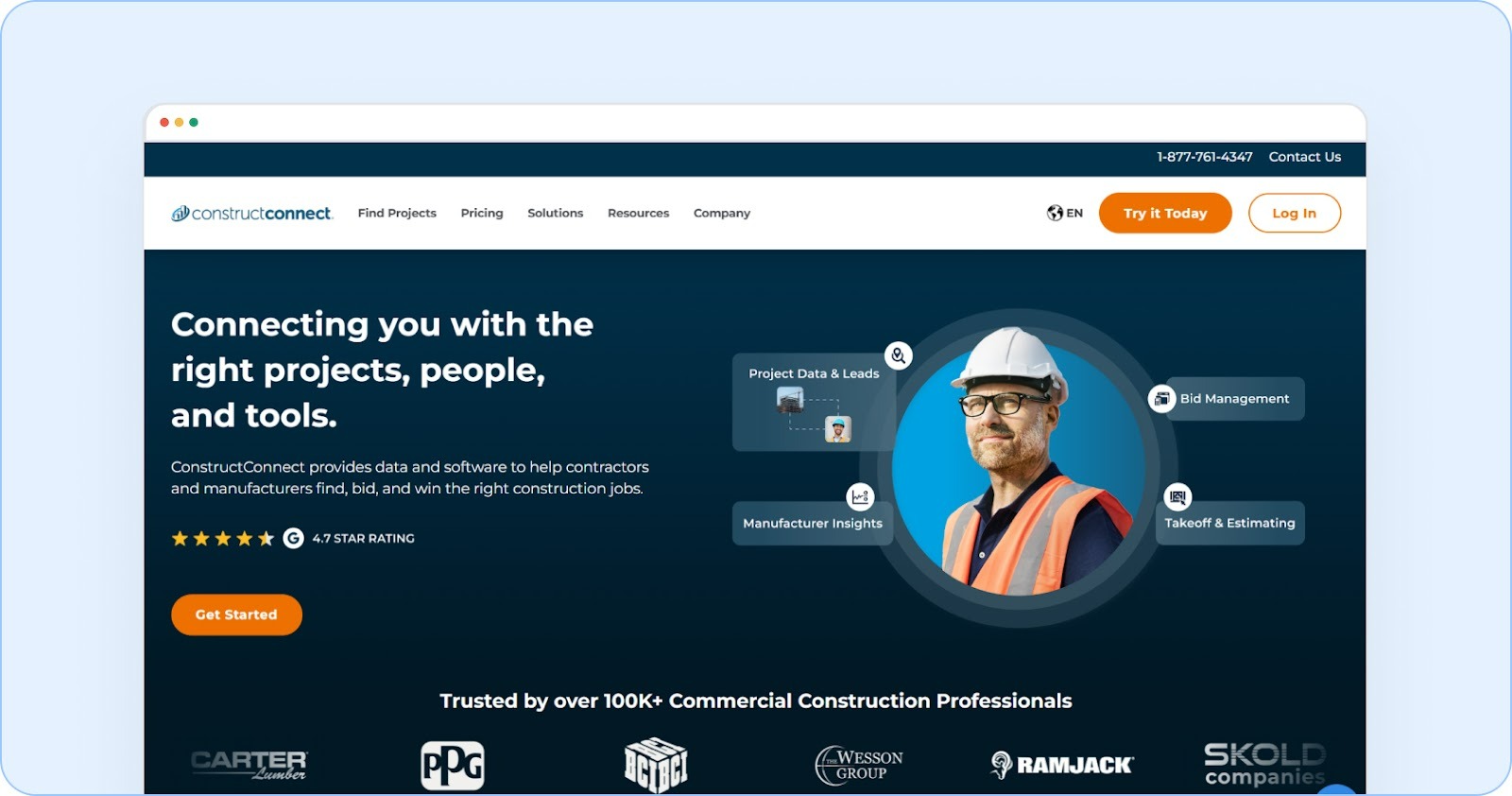
ConstructConnect is a well-established platform that offers construction product manufacturers access to a vast database of public and private projects, complete with detailed project specs, bid dates, and more. The platform also enables easy communication with contractors and developers, making it a go-to tool for finding high-quality leads.
Construction product manufacturers can use ConstructConnect to track upcoming bids and submit offers directly to contractors, ensuring they never miss out on an opportunity.

The Blue Book is a comprehensive directory and lead generation platform that helps construction product manufacturers build connections with contractors, subcontractors, and other professionals in the industry.
Through this platform, manufacturers can access detailed project leads and network with key industry players.
Manufacturers can use The Blue Book to get listed, increase visibility, and connect directly with contractors and project managers who are interested in their products.
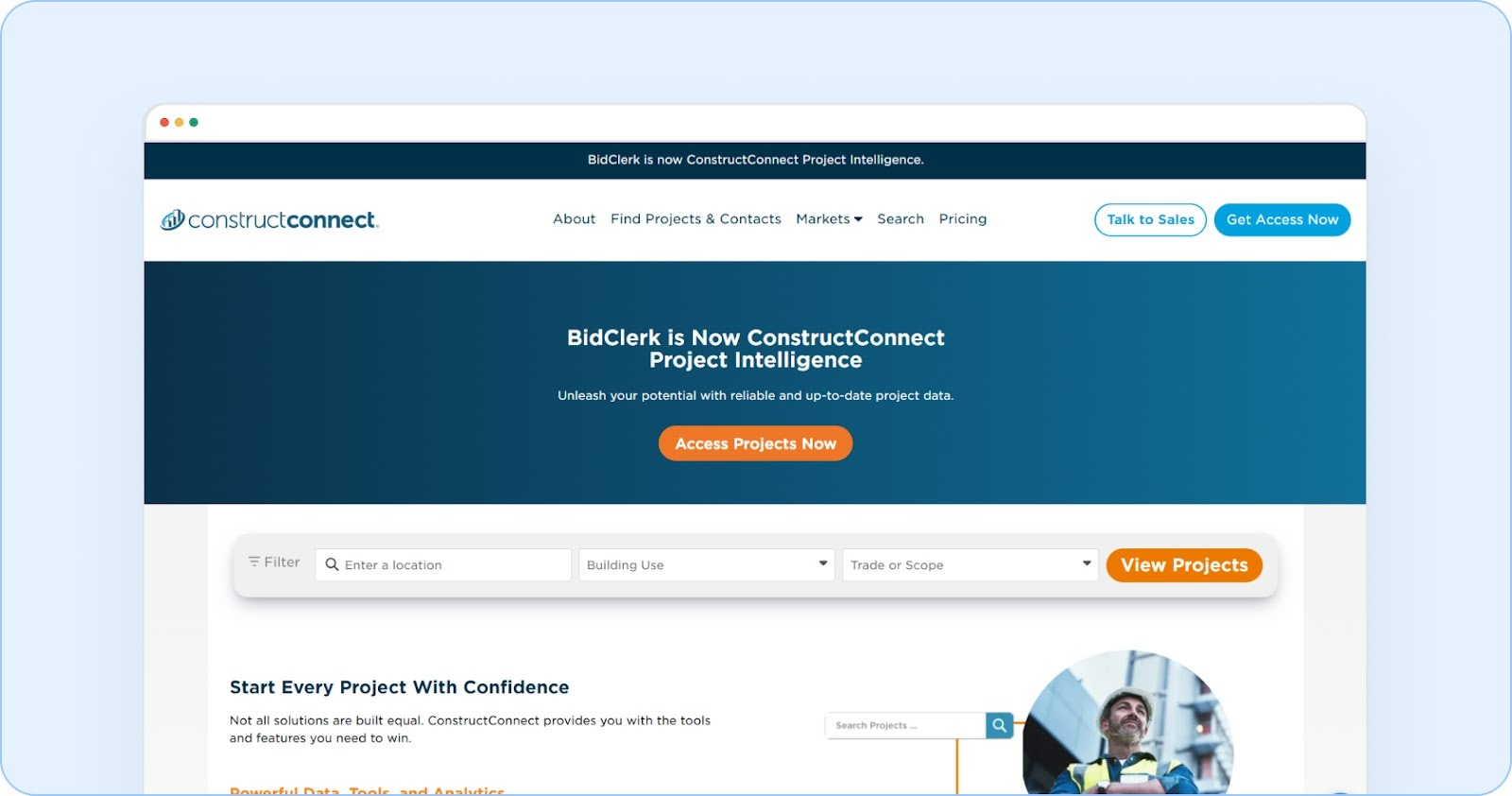
BidClerk is a powerful platform offering access to a vast database of commercial and residential construction leads. Manufacturers can tap into this resource to discover high-quality projects and ensure they are always in the loop on new bidding opportunities.
Manufacturers can use BidClerk to filter projects relevant to their products, whether it's for large-scale commercial buildings or residential renovations, ensuring they’re always bidding on the right opportunities.

LinkedIn Sales Navigator is a premier B2B sales tool that connects manufacturers with decision-makers in the construction industry. With its powerful search filters and advanced targeting, it’s an essential tool for manufacturers aiming to build relationships with key stakeholders in the construction world.
Manufacturers can use LinkedIn Sales Navigator to target and engage with contractors, architects, and developers who are actively seeking the construction products they offer, ensuring more meaningful connections and higher-quality leads.
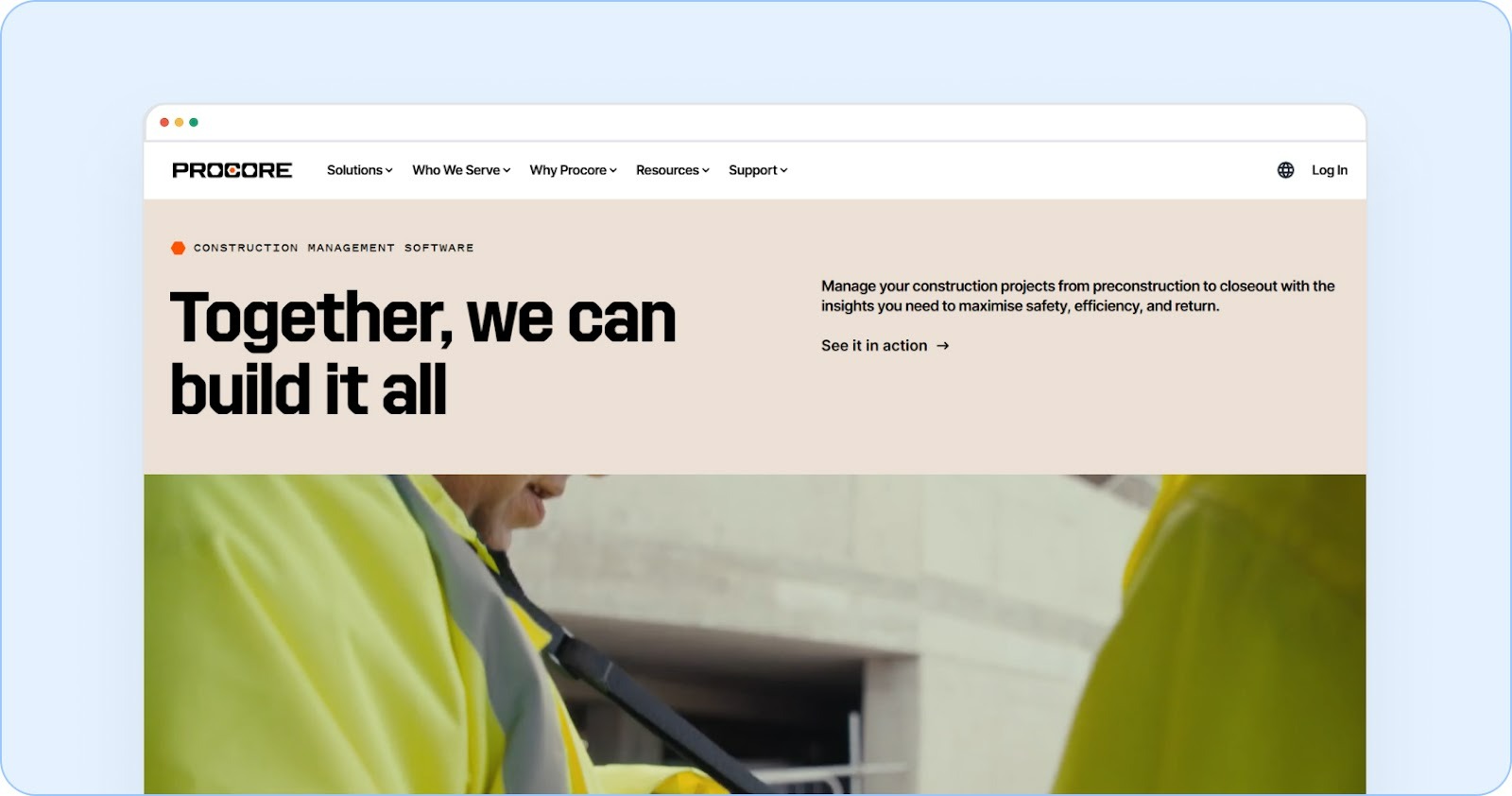
Procore is a comprehensive construction management software that streamlines project workflows and serves as a powerful lead generation platform for manufacturers. Procore connects you directly with project managers, contractors, and subcontractors who are in need of your products.
Construction product manufacturers can use Procore to stay in constant contact with project managers, ensuring they are involved in the early stages of a project and can supply their products as needed. This proactive approach keeps them competitive and relevant.
Effectively integrating lead generation platforms into your sales process is key to maximizing the quality of your leads and improving overall sales efficiency. Without proper integration, your team may struggle to track, follow up on, or act on high-quality leads quickly enough.
By connecting these platforms with your existing systems, you can ensure a seamless flow from lead discovery to conversion.
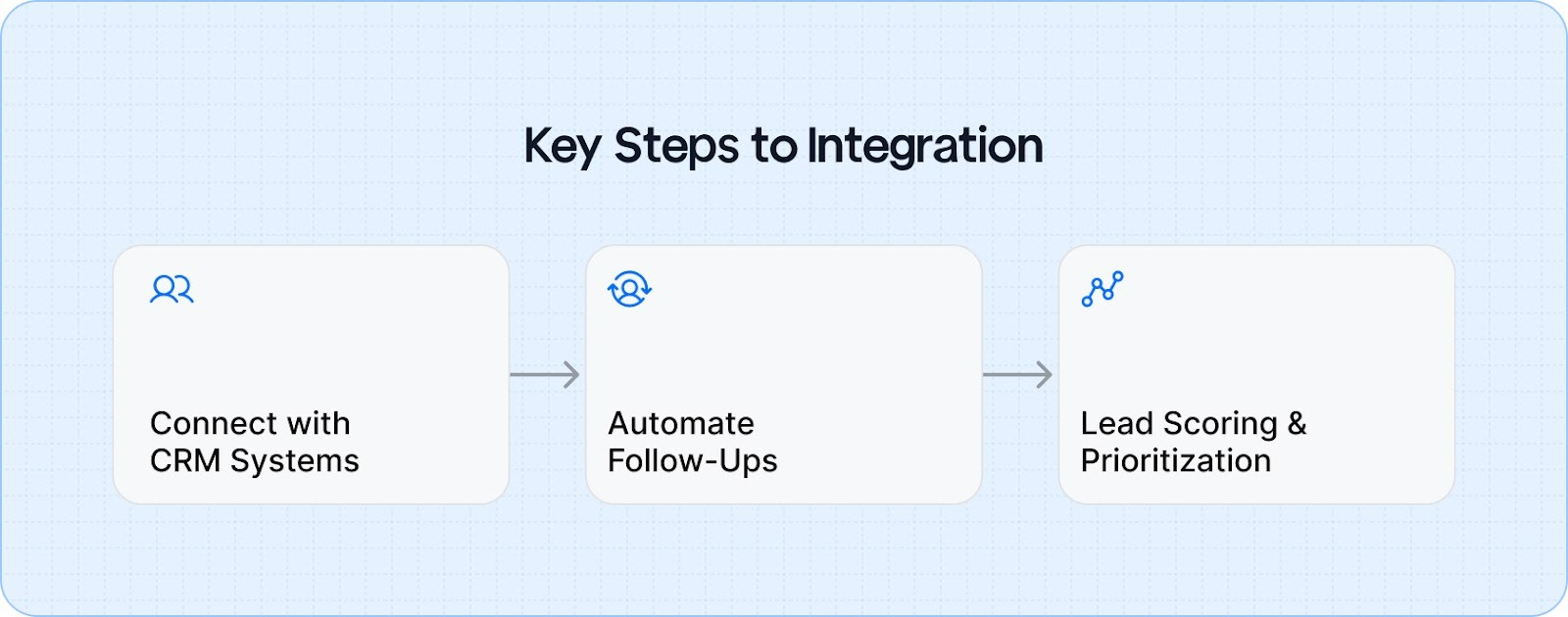
To avoid losing track of leads or missing follow-ups, sync your lead generation platforms like Gushwork, Building Radar, or ConstructConnect with your CRM (Customer Relationship Management) system.
By doing this, all incoming leads from these platforms will automatically be added to your CRM, allowing your sales team to track and manage them in one place.
Why It Matters?
This ensures that no leads slip through the cracks, and your sales team can easily access key information such as lead status, interaction history, and next steps.
Follow-ups are crucial in the lead conversion process, but they can be time-consuming. By integrating your lead generation tools with email marketing platforms or sales automation software, you can set up automated follow-up sequences for different types of leads.
For example, a new lead can receive an initial thank-you email, followed by personalized content, and later reminders about your products.
Why It Matters?
Automation saves your team valuable time while ensuring consistent communication, increasing the likelihood of turning leads into customers.
Not all leads are created equal. Use AI-powered platforms within your lead generation platforms to assign a "score" to each lead based on their behavior, engagement, and likelihood to convert. This scoring system helps prioritize leads so your sales team can focus on the highest-value prospects first.
Why It Matters?
By focusing on the leads most likely to convert, your team can use its time and resources more efficiently, resulting in higher conversion rates and less wasted effort.
Also Read: Manufacturing Lead Generation: A Complete Guide to Building Your Sales Pipeline
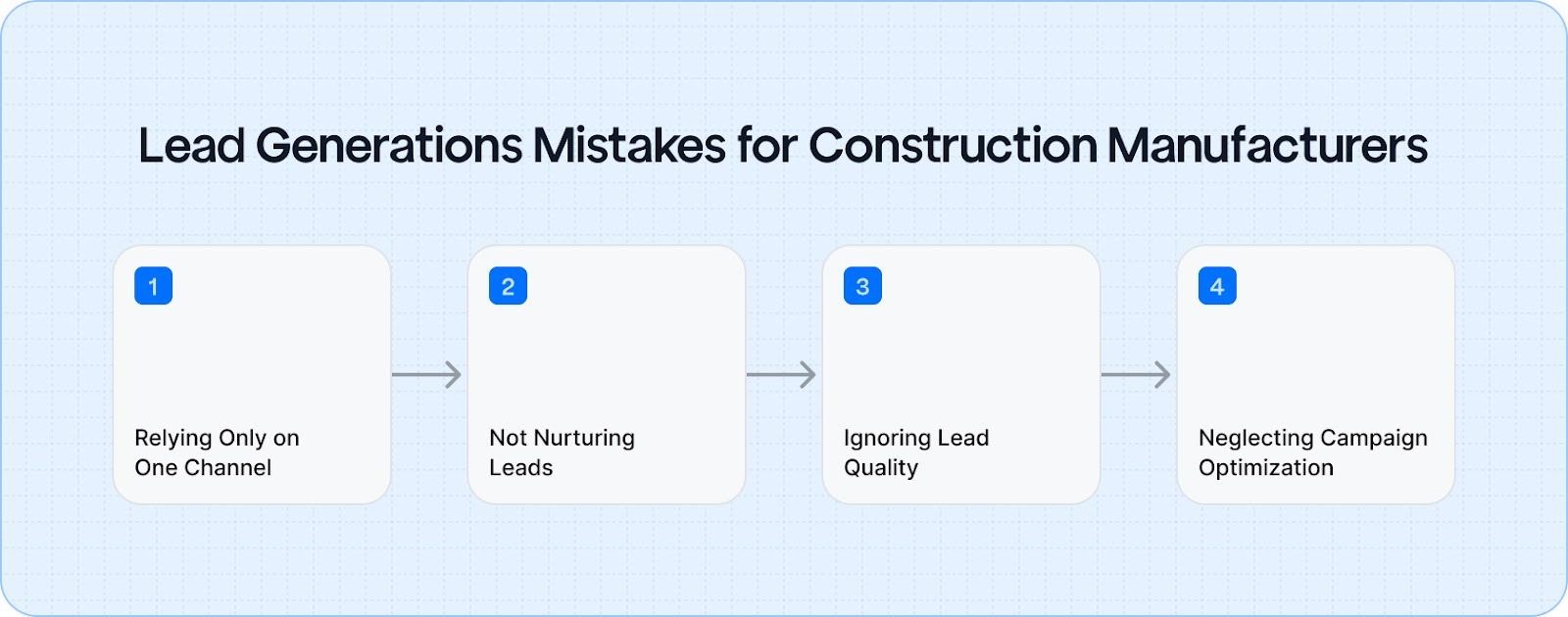
Avoiding key mistakes in your lead generation strategy can significantly improve the quality of your leads, save time, and prevent wasted resources. Here are some of the most common pitfalls to watch out for, along with actionable solutions to help you avoid them.
Focusing all your lead generation efforts on a single tool or method, such as cold-calling or one lead database, can limit your reach and effectiveness. Relying on just one platform restricts your exposure to a narrow audience and can lead to missed opportunities.
Solution: Diversify your approach by combining various lead generation platforms like Gushwork, email campaigns, SEO strategies, and networking events. This will help you reach a wider pool of potential leads and improve your chances of engaging with qualified prospects.
By using a multi-channel strategy, you ensure a steady flow of opportunities from different sources, increasing the likelihood of connecting with the right people.
Many manufacturers make the mistake of focusing solely on capturing leads and neglecting the critical nurturing phase. Leads may lose interest or become cold if not properly engaged with ongoing communication.
Solution: Implement lead nurturing strategies like automated email sequences, retargeting ads, and regular follow-up check-ins to keep leads engaged and move them closer to making a purchase.
Nurturing ensures that you stay top-of-mind, building trust and demonstrating value to potential customers over time. This process is essential to turning cold leads into loyal clients.
Focusing on the quantity of leads over their quality can waste resources and reduce conversion rates. Not all leads are equal, and some may not even be relevant to your business.
Solution: Partner with platforms like Gushwork to filter leads based on project relevance, budget, and alignment with your product offerings. Lead qualification platforms ensure you're targeting the right audience, which boosts your chances of converting leads into sales.
Prioritize leads that match your ideal customer profile, so your sales team can focus on the most promising opportunities.
Without tracking the performance of your lead generation campaigns, it’s impossible to know which strategies are working and which are not. Failing to analyze key metrics can lead to ineffective campaigns and wasted resources.
Solution: Regularly monitor metrics like conversion rates, cost-per-lead, and ROI for each channel. Platforms like Gushwork can provide insights into your lead quality and campaign success.
By analyzing these metrics, you can refine your strategy, adjust your approach, and ensure you're maximizing your lead generation efforts.
By avoiding these common mistakes, you’ll streamline your lead generation process, improve the quality of your prospects, and ultimately increase your conversion rates. Ensure you’re incorporating the right platforms and strategies to make the most out of every lead.
Lead generation for construction product manufacturers doesn’t have to be a struggle. The right platforms, like Gushwork, can help you automate processes, target high-quality leads, and boost your sales pipeline.
Outdated methods are holding you back, but with AI-powered automation and industry-specific databases, you can stay ahead of the competition and connect with the right people.
Don’t let your lead generation efforts be inefficient. Embrace the platforms that will take your business to the next level and start seeing real results.
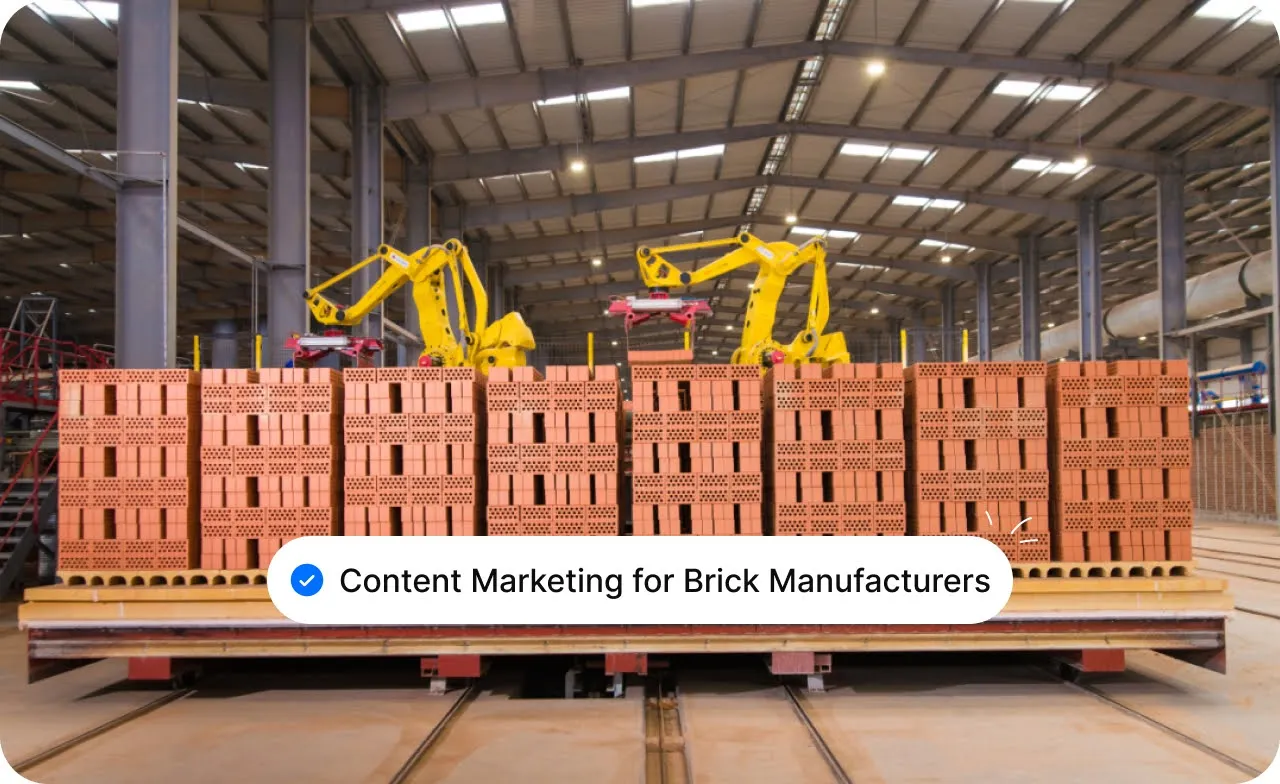
When was the last time someone chose a brick supplier just because the price looked good on a brochure?
They didn’t. And you know that. Decisions in the brick manufacturing industry are slow, deliberate, and deeply tied to trust. Buyers want to see how your bricks perform, how consistent your production is, and how your material holds up across real projects and real conditions. That confidence is rarely built through sales calls alone. It’s built through the information they find when they research you on their own.
This is where content marketing becomes far more than a marketing strategy. It becomes proof of reliability. A quiet way to show your standards, your process, and the thinking that goes into every batch you produce.
This blog explores how content marketing can help brick manufacturers strengthen credibility, influence decision makers early, and turn interest into meaningful enquiries.
Content marketing for the brick manufacturing industry is about guiding choice at the specification stage. It supports the moment when architects, builders, and contractors decide which materials will shape the structure of a project.
Instead of promoting products, effective content:
This type of content works quietly but powerfully. It positions your brand as a reliable source of information, not just a supplier. And when buyers feel informed, their decisions carry more confidence. That is where trust forms and leads follow.
Also Read: Master the Art of Utilizing Content Marketing at Trade Shows: A Step-by-Step Guide
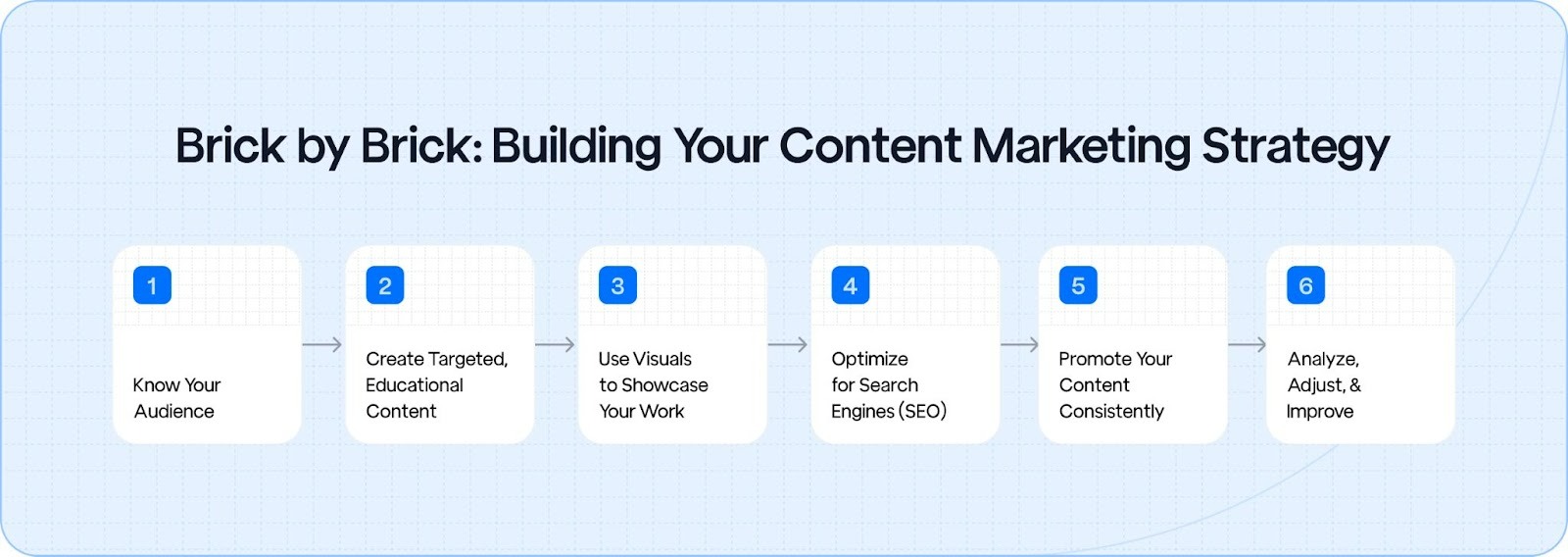
Here’s how you can build a strategy that works, step-by-step:
To start building your strategy, you need to understand the exact problems your audience is trying to solve. Are they contractors looking for reliable, durable materials? Or architects seeking sustainable building options?
Pinpointing these specific needs will guide the type of content you create. How-to guides, product comparisons, and case studies should be laser-focused on addressing your audience’s pain points.
Content that educates helps them make informed decisions. For example:
These types of content establish your company as a trusted expert, not just a seller.
Don’t underestimate the power of visuals. Photos of your bricks in finished projects, video tours of your manufacturing process, and infographics breaking down brick durability grab attention and help customers understand the tangible benefits of your product.
A behind-the-scenes factory tour or a time-lapse of a construction project using your bricks could provide that “wow” factor that engages potential clients.
Even the best content won’t help if people can’t find it. SEO optimization ensures that your content reaches the right audience. Focus on keywords specific to the brick manufacturing industry, terms like “durable bricks,” “eco-friendly building materials,” and “best bricks for high-traffic areas.”
By incorporating these keywords naturally into your blog posts, case studies, and product descriptions, you increase the chances of appearing in search engine results when potential customers are looking for solutions.
Like laying bricks in a wall, distribute your content consistently across channels like your website, email newsletters, and social media. Engage with your audience through comments, shares, and likes, and make sure your content resonates. Consistency helps build momentum, keeping your company top-of-mind for your audience.
Finally, don’t forget to measure the impact of your content. Use tools like Google Analytics, social media insights, and customer feedback to gauge what’s working and what’s not.
Are certain blog topics generating more leads? Is your video content getting more engagement than written posts? Use these insights to refine your strategy and ensure your content is as effective as possible.
Each step is essential to building a robust, effective strategy that supports your business long-term. Over time, you’ll have a solid content foundation that attracts, educates, and converts your audience into loyal customers.

Content marketing for brick manufacturers isn’t a one-size-fits-all solution. It requires a personalized, strategic approach that reflects your unique value proposition and reaches the right audience in the right way. Here are the essential strategies to ensure your content resonates and drives results.
Your website is the backbone of your content marketing strategy. It’s where potential customers go to learn more about your products, company, and values. To turn your site into a lead-generating machine, it needs to be more than just a digital brochure. Here’s how to optimize it:
Your website is the digital storefront that should provide the exact information potential clients are looking for, while guiding them smoothly toward making a purchase.
Social media is no longer just for B2C brands. It's a powerful tool for B2B manufacturers too, especially in industries like brick manufacturing. Platforms like LinkedIn, Facebook, and Pinterest are essential for building your brand’s presence and engaging with your target audience.
By regularly posting relevant, engaging content, you can increase your visibility and connect with decision-makers in the construction and architecture industries.
Email marketing is a cost-effective way to stay top-of-mind with your customers, nurture leads, and provide valuable industry insights. Here’s how to use it effectively:
Email marketing offers a direct line to your audience, making it a key strategy for brick manufacturers looking to maintain relationships with existing clients and convert new ones.
Also Read: The B2B Manufacturing Marketing System: Build Visibility, Trust, and Sales
In today’s digital marketing landscape, data is your best friend. But only if you know how to use it.
With the right analytics tools and techniques, brick manufacturers can make smarter, data-driven decisions that lead to better content, higher engagement, and ultimately, more conversions.
Here’s how you can use data to elevate your marketing efforts:
Understanding how well your content is performing is crucial for optimizing your strategy. By using tools like Google Analytics, social media insights, and CRM software, you can gain actionable data to refine your content.

Key performance metrics (KPIs) to track include:
By regularly monitoring these metrics, you can see which types of content are resonating with your audience and adjust your strategy accordingly.
Not all your customers are the same, so why treat them like they are? Segmentation allows you to break your audience into smaller, more manageable groups based on criteria like:
Tailoring content for these specific personas ensures that each group receives the information most relevant to them. For example, an architect might appreciate a blog post on the aesthetic qualities of brick, while a contractor might be more interested in content focused on durability and cost-effectiveness.
Personalization increases engagement, builds stronger relationships, and drives more qualified leads to your business.
Once your content is live, how do you know if it’s effective? The answer lies in A/B testing. This testing allows you to compare two versions of a piece of content, whether that’s an email subject line, a landing page, or a blog title, to see which performs better.
It’s a powerful tool for continuously refining your strategy and ensuring you're always moving toward higher conversion rates.
By analyzing the results of A/B tests, you can identify which messaging, formats, and CTAs resonate most with your audience and make adjustments accordingly. Even small tweaks can result in better engagement and higher conversion rates over time.
Here are some common pitfalls and how to avoid them:
Bricks are, by nature, a technical product. But that doesn’t mean your content needs to be overly technical or jargon-heavy. The key is to strike the right balance between providing enough detail while keeping things accessible for a broad audience. Here’s how:
It’s easy to fall into the trap of cranking out blog posts, social media updates, and emails just for the sake of it. But content overload can lead to burnout, confusion, and disengagement. Here’s how to focus on quality over quantity:
Here’s how to maintain a strong, reliable presence in the digital world.
Interactive content is one of the most effective ways to engage your audience and keep them coming back. Tools like quizzes, calculators, and product selectors allow your prospects to actively participate in the content experience. For example:
Interactive content provides value and encourages visitors to spend more time on your website, increasing the chances of conversion.
Content marketing is a two-way street, and by responding to comments on social media, blog posts, and email newsletters, you create meaningful conversations that build trust. Here’s how to engage effectively:
When your audience feels heard and valued, they’re more likely to return for more information, turning them into loyal customers.
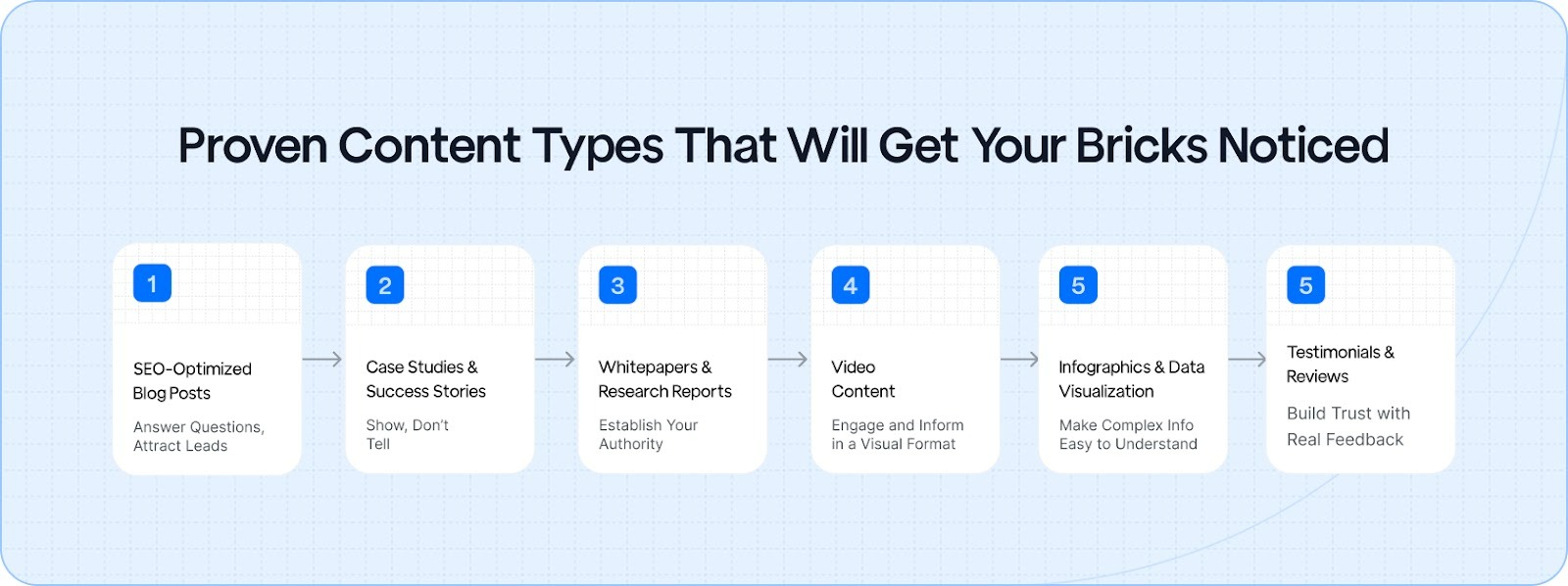
Content marketing for brick manufacturers requires writing blog posts and creating valuable, diverse content that serves both your audience and your business goals. Let’s look at the types of content that will help your brand stand out.
SEO isn’t just a buzzword; it’s the key to getting your content found by the right people. To ensure your content reaches potential customers, focus on creating SEO-optimized blog posts that answer common industry questions. For example:
These blog posts help educate your audience and drive organic traffic to your site by ranking for the questions your potential customers are searching for.
Also Read: How Manufacturers Can Win More Leads With SEO
Nothing builds trust like real-world success. Case studies and success stories are powerful tools for showing how your bricks have been successfully used in large projects. Highlight the challenges faced by your clients, how your bricks solved their problems, and the positive outcomes.
This content adds credibility to your product and positions your company as a solution provider.
Whitepapers and in-depth research reports are perfect for demonstrating your industry knowledge and positioning your company as an authority. These resources give your audience insights into the latest trends, technologies, and best practices in the brick industry.
Videos are an incredibly engaging way to convey information. From how-to guides to factory tours, videos provide a visual connection that written content can’t match. Here are some video content ideas for your brick business:
Infographics and data visualizations are the perfect way to explain complex concepts quickly and clearly. For example, create an infographic that compares the durability of different types of bricks or breaks down the environmental benefits of using eco-friendly bricks. This format makes it easier for your audience to digest valuable information and share it with others.
The best marketing comes from your existing customers. Customer testimonials and reviews provide social proof, showing potential clients that your products live up to their promises. Ask happy customers to share their experience using your bricks, and showcase their stories on your website, social media, and product pages.
Marketing bricks isn’t without its challenges, and understanding these hurdles is the first step to overcoming them. The brick industry is filled with unique complexities, but with the right approach, you can turn these challenges into opportunities.
Bricks are technical products with many specifications, but that doesn’t mean your content has to be overly complex. Simplifying technical content ensures it resonates with both technical and non-technical audiences. Use easy-to-understand language, and supplement with visuals that make complex ideas easier to grasp.
The construction industry has long sales cycles, especially for large-scale projects. Keep your prospects engaged with valuable content at every stage of their buying journey. Whether it's blog posts, whitepapers, or case studies, make sure you're consistently nurturing leads until they’re ready to convert.
The brick industry is competitive, and differentiating yourself can be tough. Focus on your unique selling points, whether that’s sustainability, custom-made bricks, or superior durability, and build content around these advantages. By offering unique value, you can carve out your niche in the market.
Content marketing is your key to building a strong presence in a crowded market. With the right strategy, you can establish your brand as a leader and attract high-quality leads.
By consistently producing valuable content, you position your company as an authority in the brick manufacturing industry. Blog posts, whitepapers, and industry insights are all great ways to showcase your knowledge and help your audience solve problems.
Bricks are a major investment in construction projects, and customers want to make the right choice. Provide educational content, like how-to guides and comparison charts, to help your customers make informed decisions.
Targeting niche markets within the construction industry will help you attract the right leads. Case studies, whitepapers, and industry-specific content are excellent tools for engaging decision-makers in the construction and real estate sectors.
Optimizing your content with the right keywords will help you rank higher in search engine results. Use SEO best practices to ensure your content is discoverable by those searching for brick-related solutions.
In the brick manufacturing industry, simply attracting traffic isn’t enough. It’s about converting that traffic into qualified leads and long-term business relationships.
Content marketing allows you to build trust, educate your audience, and showcase your expertise in ways that resonate with both technical and non-technical customers.
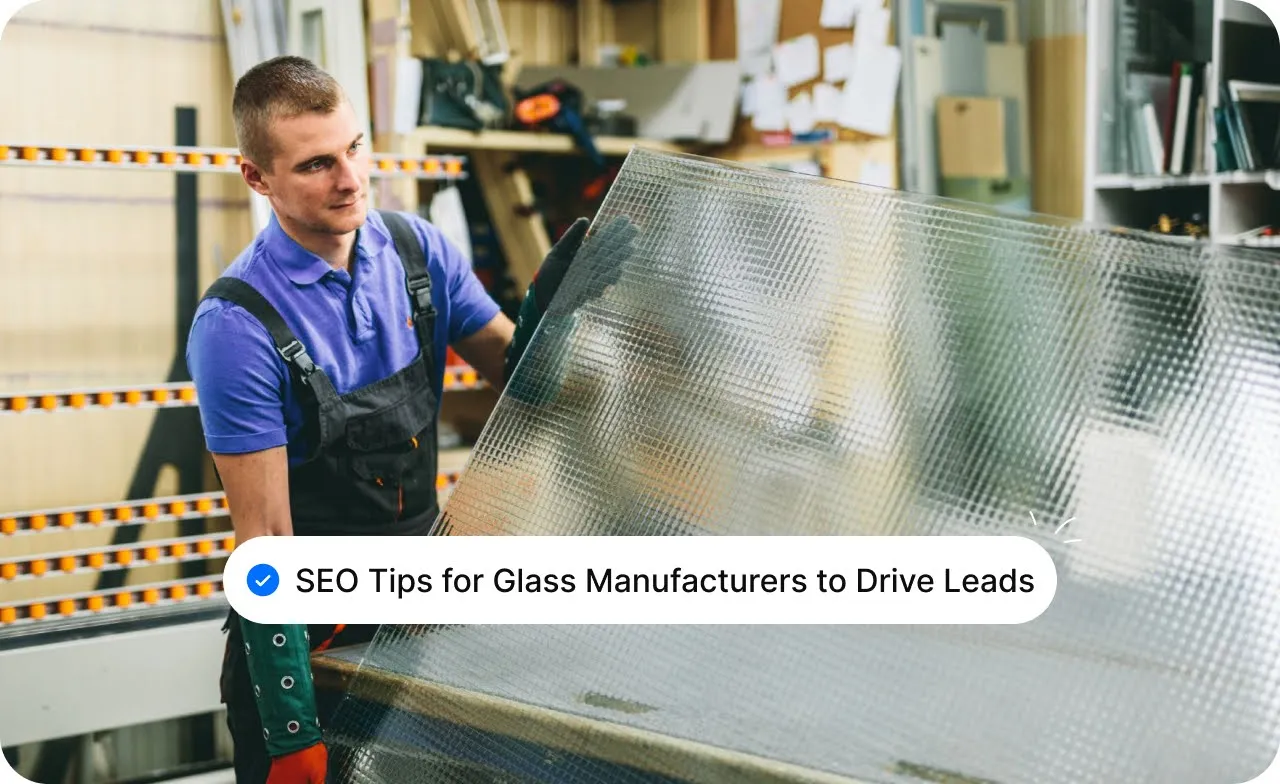
If you’re a glass manufacturer, you’ve likely faced the frustration of a website that’s buried on page 5 of search results. The truth is, in a niche industry like glass manufacturing, general SEO tactics aren’t enough.
The competition is fierce, and without a hyper-targeted SEO strategy, you’re left competing for visibility with companies offering vastly different products.
Your ideal customers, architects, builders, or procurement officers, are out there, but they’re only finding you if your SEO strategy is specific enough to make you stand out when they search for terms like "custom glass for commercial buildings" or "tempered glass suppliers near me."
This article doesn’t cover basic SEO tips; it’s about understanding the nuances of your industry and leveraging SEO to attract the right decision-makers who truly understand the complexities of glass manufacturing. From specific keywords to local SEO tactics, this blog will dive into how you can boost your search rankings and drive high-quality leads tailored to your exact market.
Keyword research is the backbone of a strong SEO strategy. For glass manufacturers, using the right keywords ensures your content reaches the relevant audience actively searching for your products.
Pro Tip: Expand your keyword list by incorporating variations of your main keywords using synonyms. This strategy broadens your reach, allowing you to capture more search traffic without overstuffing your content with repetitive phrases.
On-page SEO ensures that search engines and website visitors can easily understand and interact with your content. Glass manufacturers need to implement on-page SEO best practices to improve their site’s ranking and user engagement.
Pro Tip: Incorporate schema markup on your product pages and service descriptions.
This helps search engines understand your content better, improving the chances of appearing in rich snippets and enhancing your visibility in search results.
Local SEO is essential for glass manufacturers targeting customers in specific regions. Being visible in local searches allows you to attract nearby clients who are searching for local manufacturers, suppliers, and service providers.

Claim and optimize your Google My Business (GMB) listing for better visibility in local searches.
Pro Tip: Create location-specific landing pages for the areas you serve.
For example, create pages like “Glass Manufacturers in [City]” to rank for local search queries, which helps you target customers in specific regions and boost your visibility on search engines.
Content marketing is a great way to build trust and authority in your industry while also boosting your SEO rankings. For glass manufacturers, creating content that addresses common customer questions and educates your audience is key to improving SEO.

Regularly publish informative blog posts, case studies, and product guides to answer questions your target customers are asking.
By incorporating relevant keywords, you’ll increase your content’s chances of ranking higher in search results.
Pro Tip: Diversify your content formats. Along with written content, consider creating videos, infographics, and product demos to engage your audience further. This boosts your SEO and keeps visitors on your site longer, which is favorable for rankings.
Link building is critical for improving your website's authority in the eyes of search engines. High-quality backlinks signal to Google that your content is credible, which is crucial for ranking higher.

Pro Tip: Monitor your backlinks using tools like Ahrefs. Ensure you’re obtaining high-quality links from reputable sources, and regularly track them to evaluate the effectiveness of your link-building strategy.
Technical SEO helps ensure that your website is fast, secure, and easily crawled by search engines. For glass manufacturers, a technically sound website improves search rankings and offers a better user experience.
Optimize your website’s speed by compressing images, minifying code, and leveraging browser caching. A fast website improves both user experience and SEO rankings.
Pro Tip: Ensure your website uses HTTPS for security, as this is a ranking factor for Google. Also, regularly check for broken links and duplicate content to avoid issues that can harm your SEO performance.
Voice search is rapidly becoming more popular, and optimizing for voice queries can give you a competitive edge. As voice search continues to grow, glass manufacturers need to adapt their SEO strategies accordingly.

Focus on long-tail, conversational keywords that mirror how people speak. For example: “Where can I find glass suppliers near me?” instead of just “glass suppliers”
Pro Tip: Optimize your FAQ pages by answering common questions directly. This helps increase the chances of being featured in voice search results, as voice queries often pull answers from these sections.
Social media is not just for brand awareness; it can also impact SEO by driving traffic to your site and increasing engagement. Glass manufacturers can leverage social media platforms to improve their online presence.
Share high-quality content on platforms like Facebook, LinkedIn, and Instagram to drive traffic back to your website. Include links to your product pages or blog posts in your social media profiles.
Pro Tip: Engage with your followers by responding to comments, hosting polls, or running contests. This increases engagement and helps build a loyal online community that can share your content.
Tracking your SEO performance is essential for understanding what’s working and where improvements are needed. Regular monitoring allows you to adjust strategies to ensure continuous progress.
Use tools like Google Analytics and Google Search Console to track your website’s organic traffic, keyword rankings, and user behavior.
Pro Tip: Set up conversion tracking to measure how well your SEO efforts are turning visitors into leads or customers, providing valuable insights into your SEO strategy’s effectiveness.
Also Read: Can Google Ads Drive More Leads and Sales for Your Manufacturing Business?
With mobile-first indexing, ensuring that your website is mobile-friendly is critical for SEO success. Glass manufacturers need to ensure their website performs well on all devices to avoid ranking penalties.

Ensure your website is responsive and adjusts to various screen sizes. Google prioritizes mobile-optimized websites in search rankings.
Pro Tip: Use Google’s Mobile-Friendly Test tool to check your website’s performance on mobile devices. Make adjustments as needed to improve user experience and SEO.
Video content is a powerful tool for increasing engagement and boosting SEO. Glass manufacturers can use videos to showcase their products, explain their processes, and share customer testimonials.
Create engaging videos that highlight your products, manufacturing processes, or customer success stories. Ensure these videos are optimized for platforms like YouTube, as well as for your website.
Pro Tip: Include keyword-rich titles, descriptions, and tags in your videos to help them rank in search engines, increasing the chances of driving organic traffic.
Regularly updating old content ensures that your website remains relevant, informative, and competitive in search rankings.
Refresh outdated blog posts, product pages, and case studies by adding new information, updated statistics, or more relevant keywords.
Pro Tip: Link new content to older posts to improve the internal link structure of your site and boost SEO across all pages.
Get Yours: Custom Manufacturing Websites That Drive Sales & Build Trust
Implementing these 12 SEO tips will help glass manufacturers increase their online visibility, capture high-quality leads, and stand out in a competitive market. However, improving SEO and generating qualified leads isn't a one-time fix—it’s an ongoing process that requires optimization and automation for long-term success.
Many manufacturers struggle with overwhelming marketing tasks and inconsistent results. The DIY approach is no longer enough to stay competitive.
Q1. What is SEO for glass manufacturers?
A1. SEO for glass manufacturers involves optimizing your website and content to rank higher on search engines for industry-specific and location-based keywords. It helps attract potential clients by improving visibility and driving relevant traffic to your site.
Q2. How can keyword research improve my SEO strategy?
A2. Keyword research helps identify high-intent search terms your potential customers use when searching for glass products or services. By targeting these keywords in your content, you can improve your rankings and attract the right audience, ultimately generating more leads.
Q3. How important is local SEO for glass manufacturers?
A3. Local SEO is crucial for glass manufacturers as it helps you attract customers in specific regions. By optimizing your Google My Business listing and creating location-specific landing pages, you increase your chances of showing up in local search results, making it easier for nearby clients to find you.
Q4. How can video content improve my SEO?
A4. Video content boosts engagement by keeping visitors on your site longer, which positively impacts your SEO rankings. Additionally, optimized videos can rank on platforms like YouTube, driving more traffic back to your website and increasing brand visibility.
Q5. What are some effective link-building strategies for glass manufacturers?
A5. Earning backlinks from authoritative sources like industry websites, directories, and blogs is key to improving your domain authority. Participating in guest posts, collaborations, and getting listed on trusted industry directories are some of the most effective strategies.
Q6. How can Gushwork help improve my SEO and lead generation?
A6.Gushwork integrates AI-powered tools to automate SEO processes, optimize lead generation, and ensure faster, more consistent results. By streamlining your marketing efforts, you can focus on high-value strategies that drive qualified leads and improve your online presence.





.svg)
.svg)
.svg)